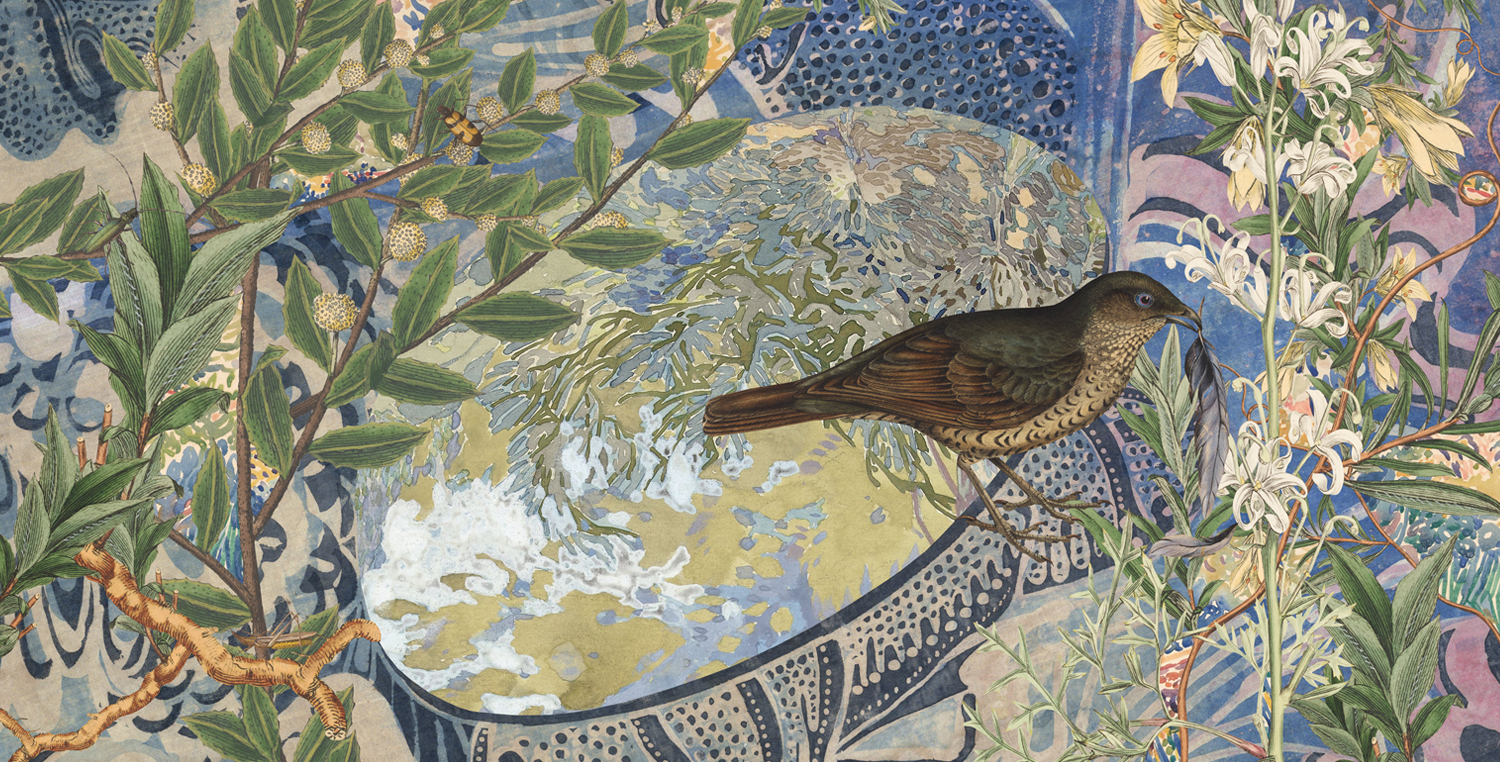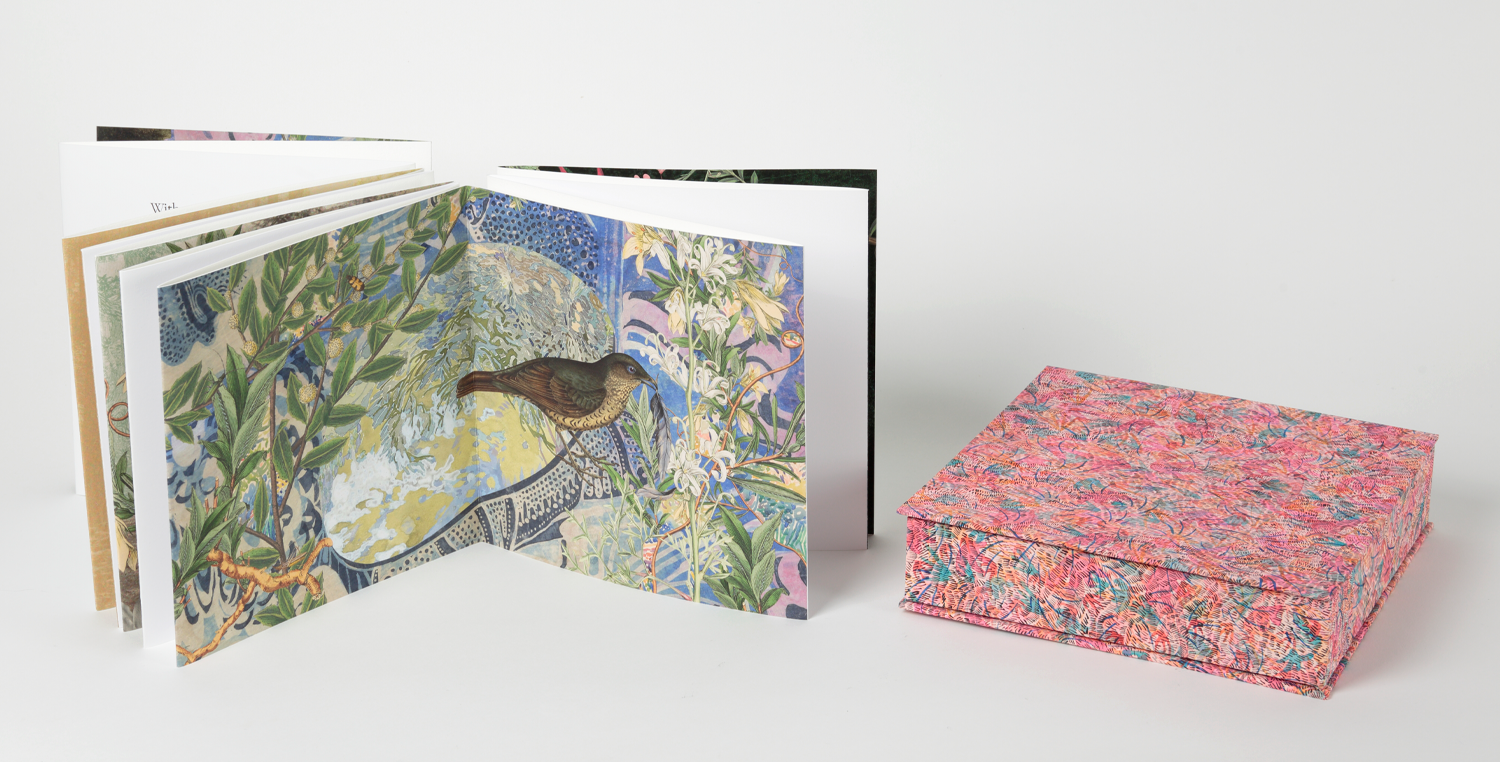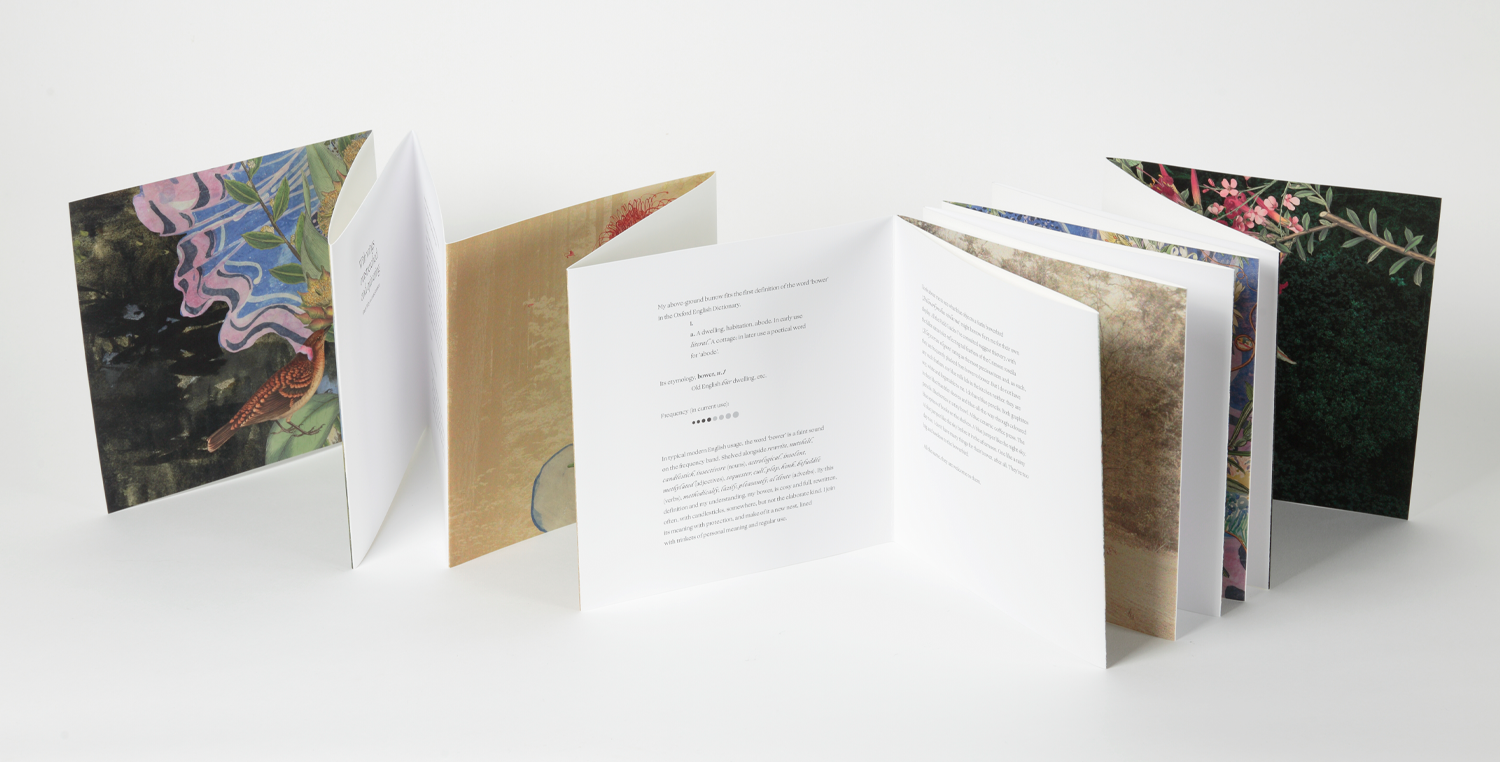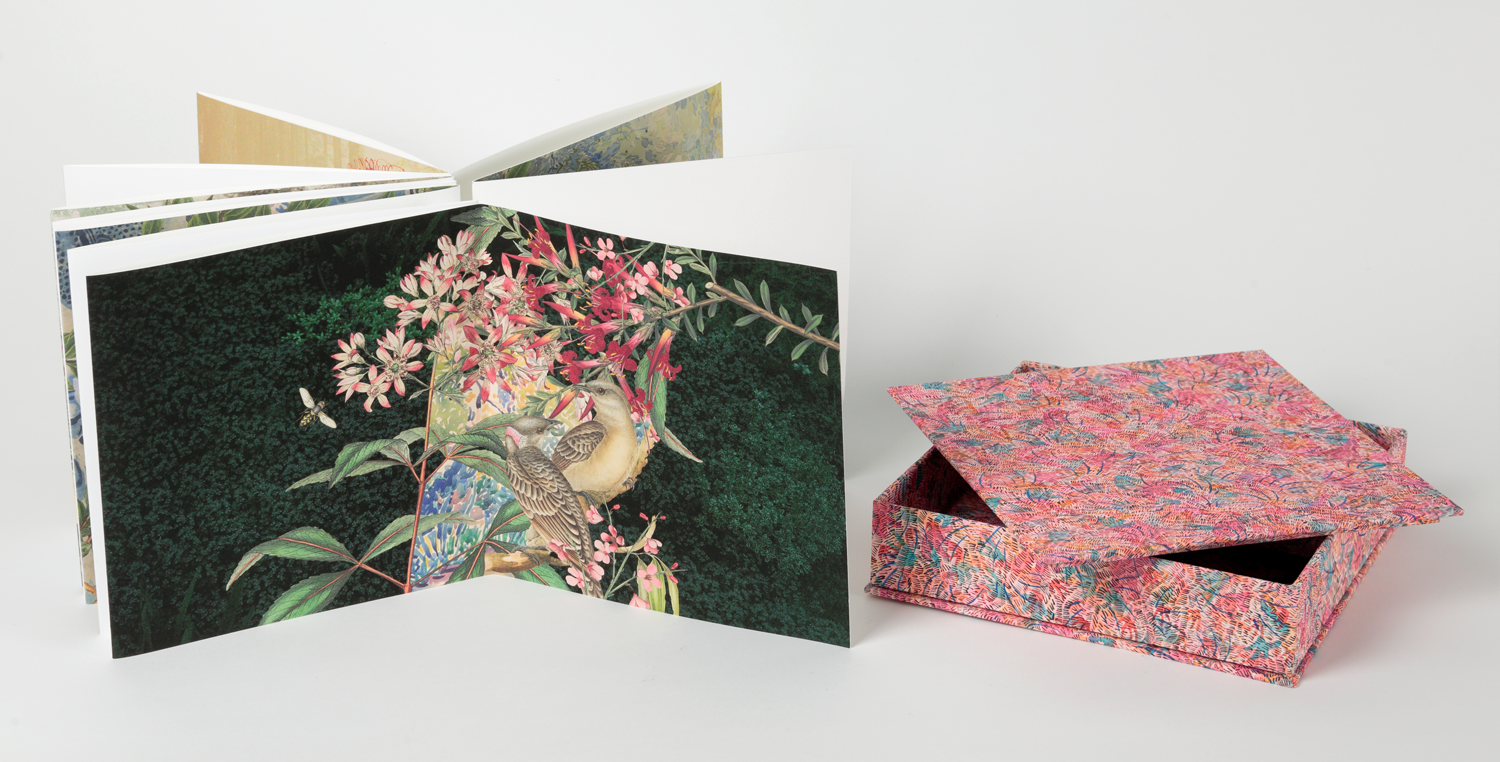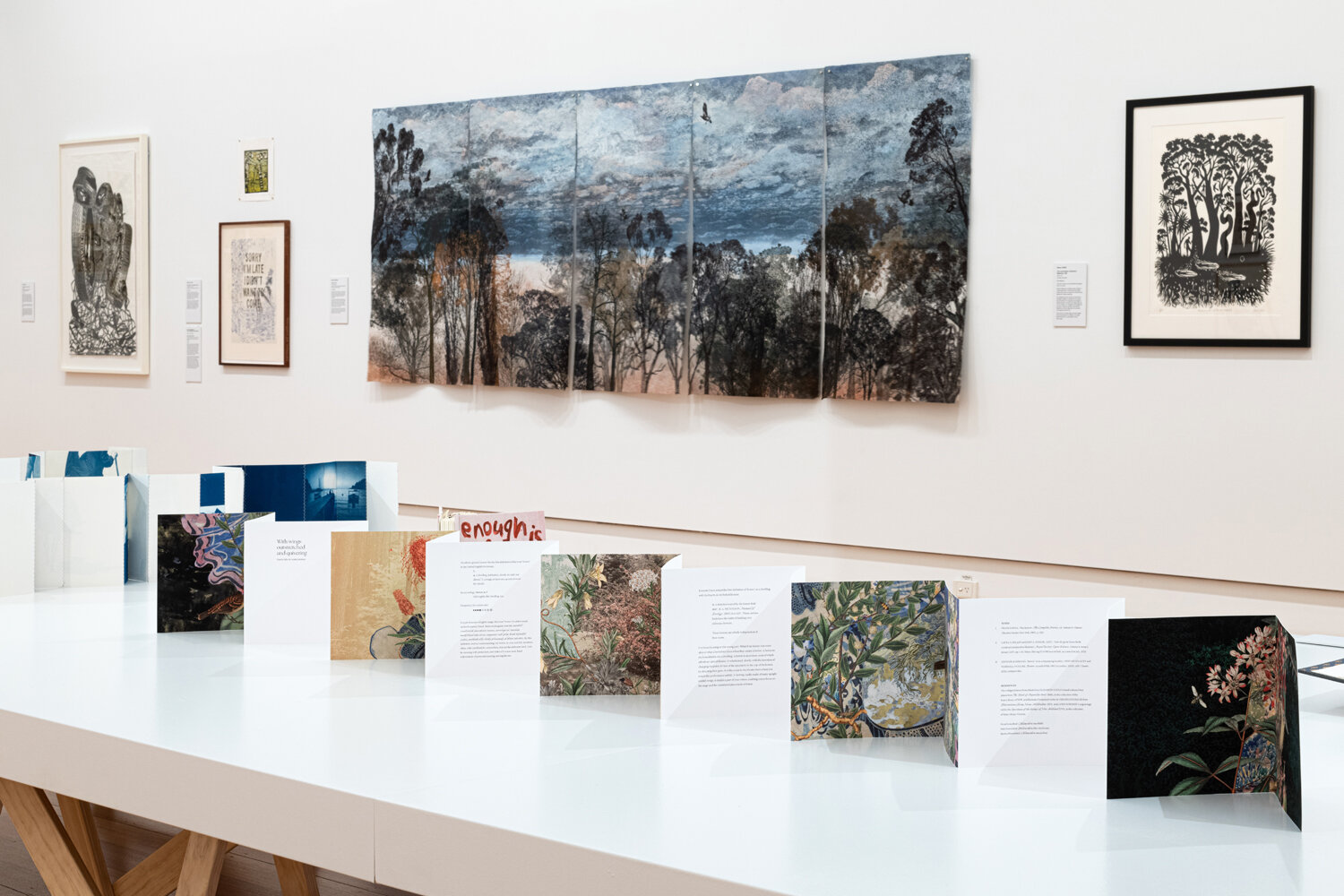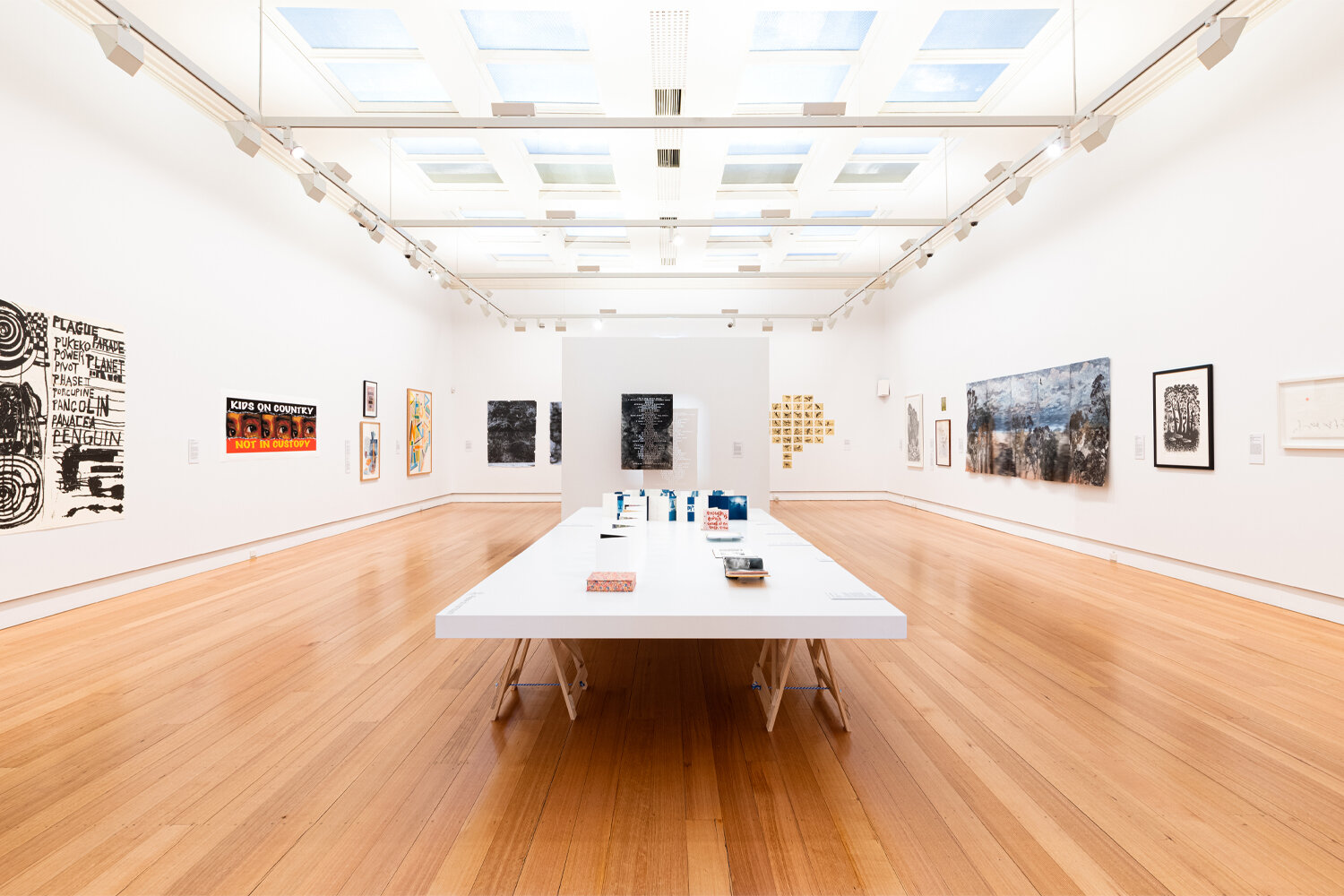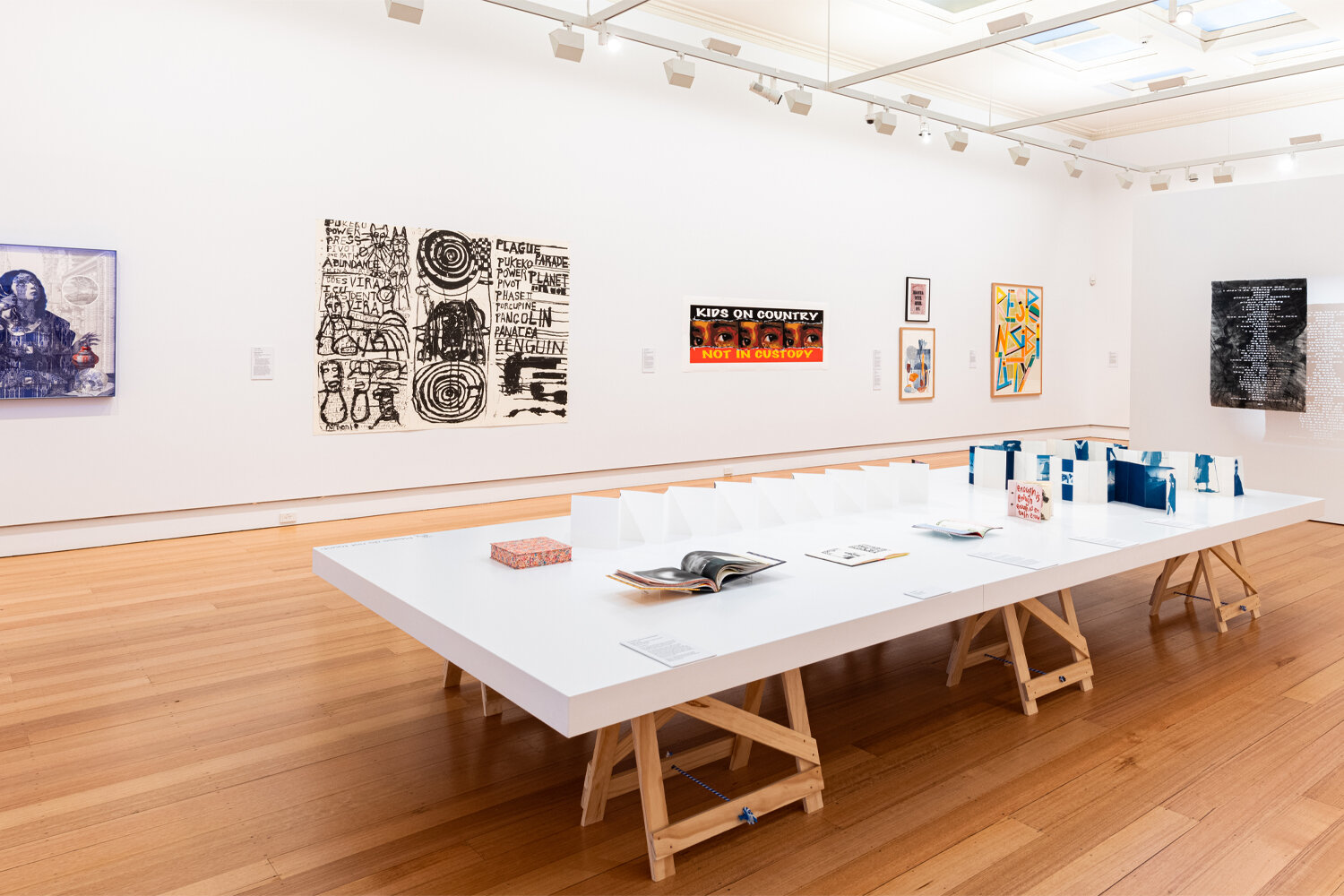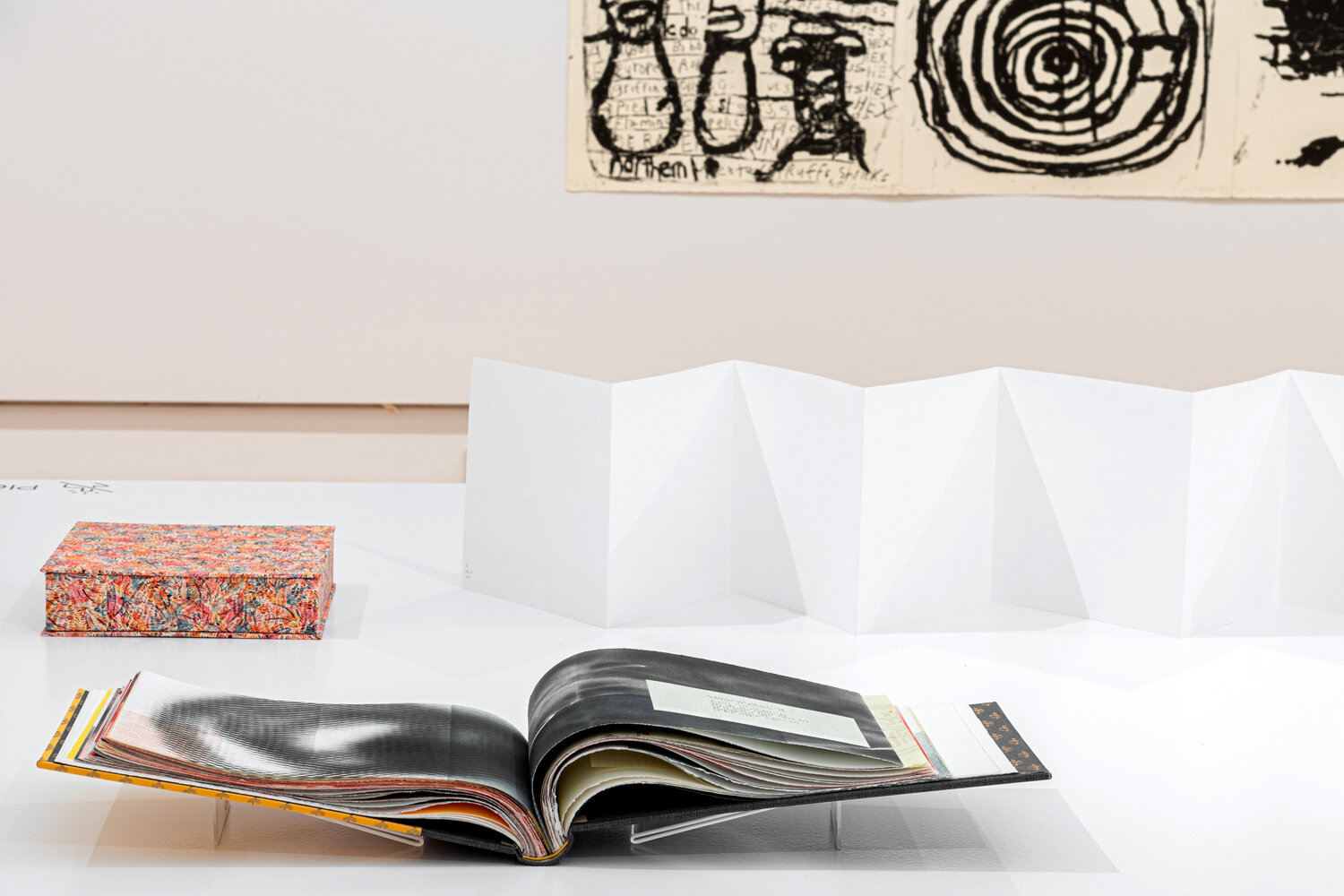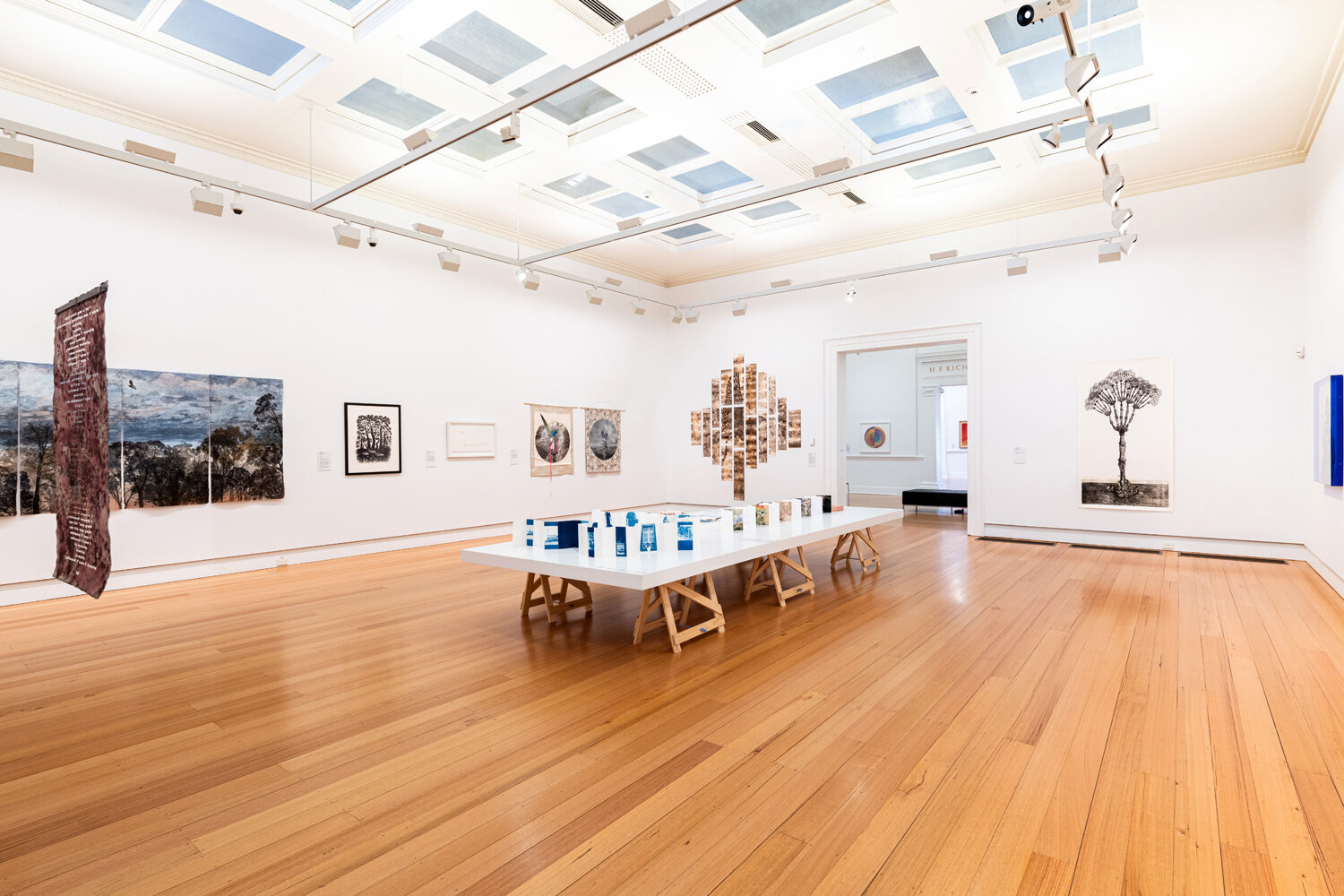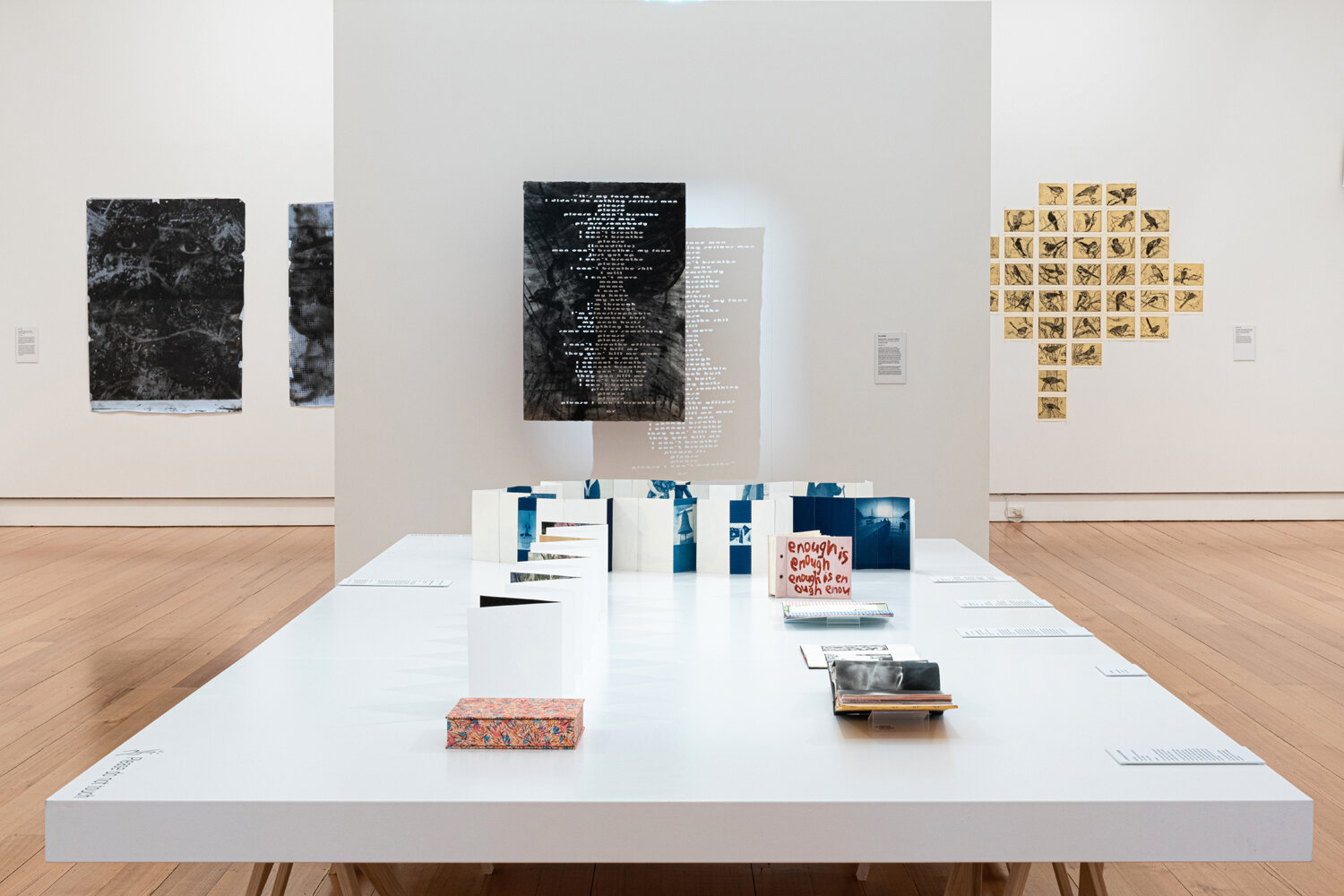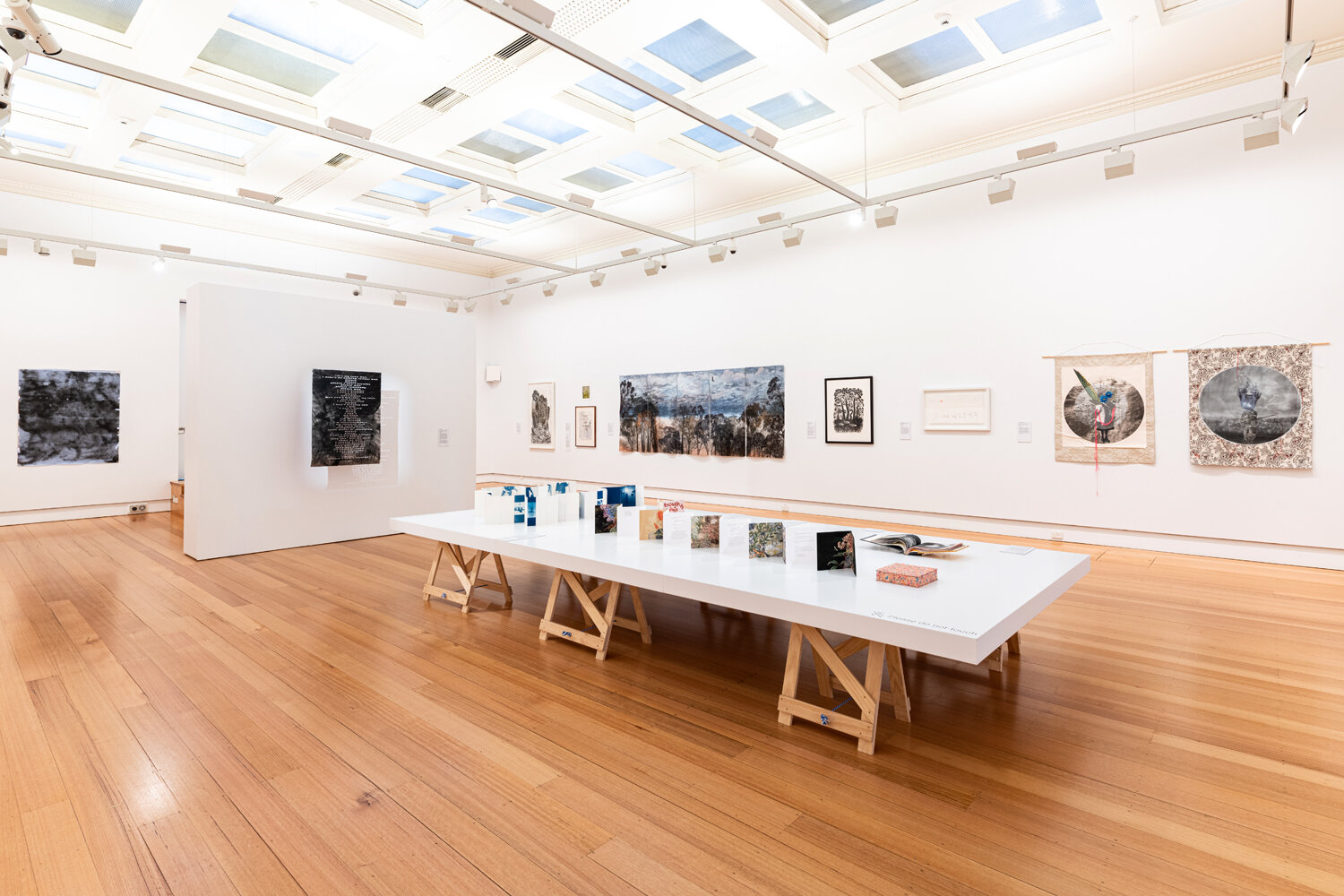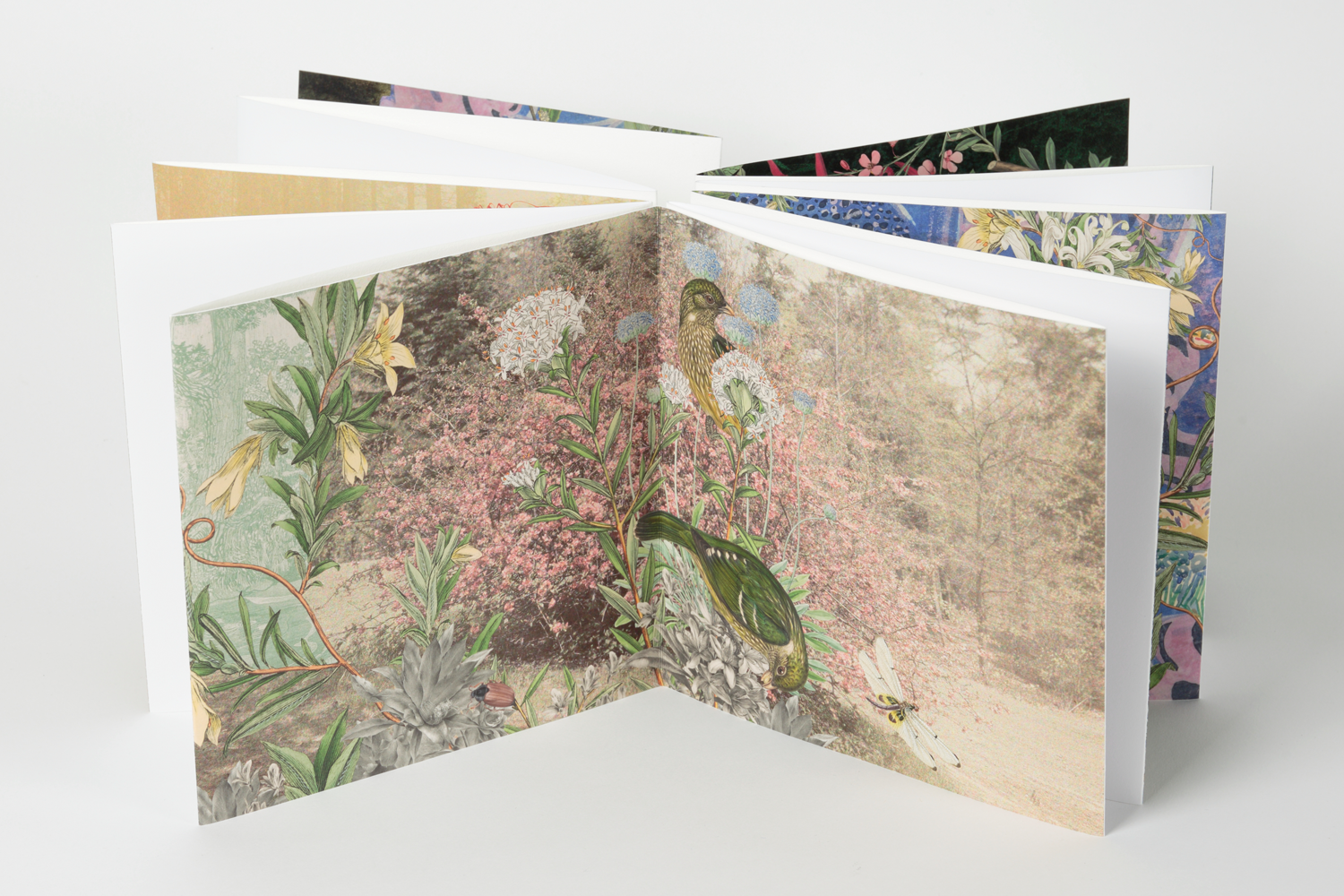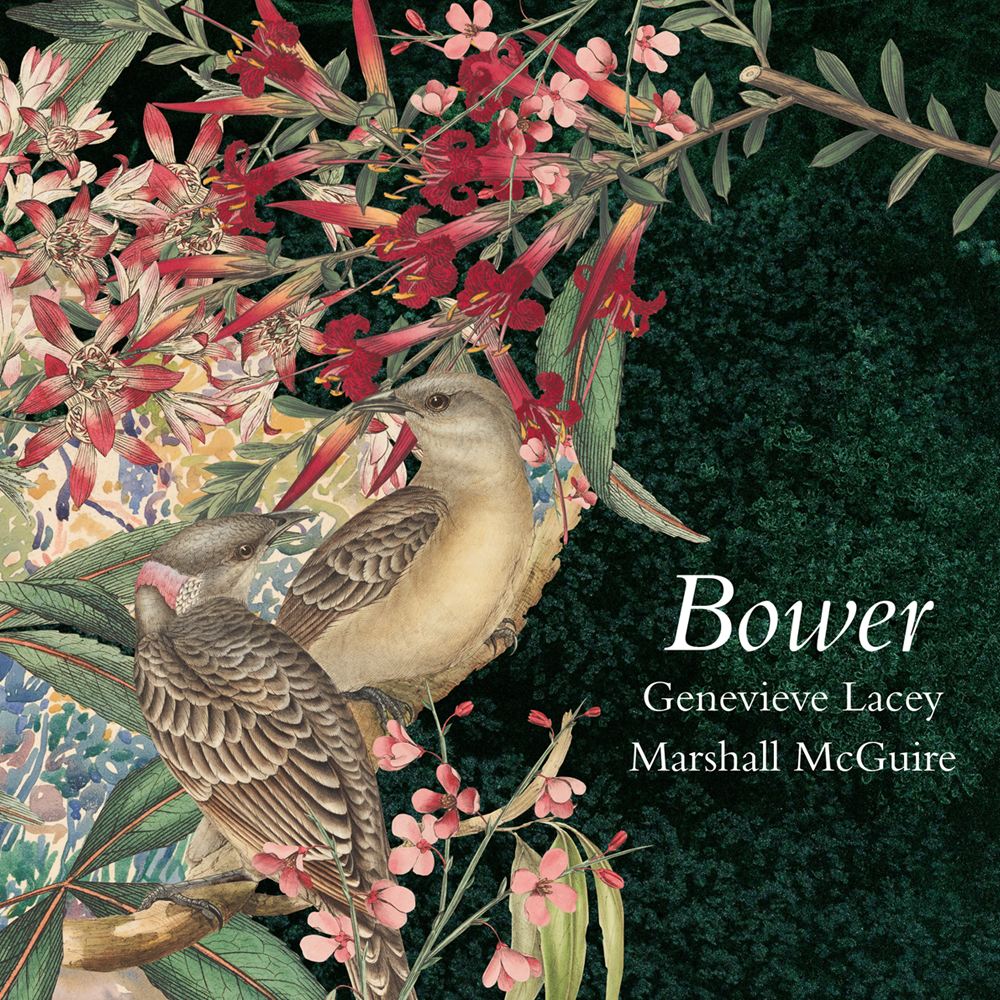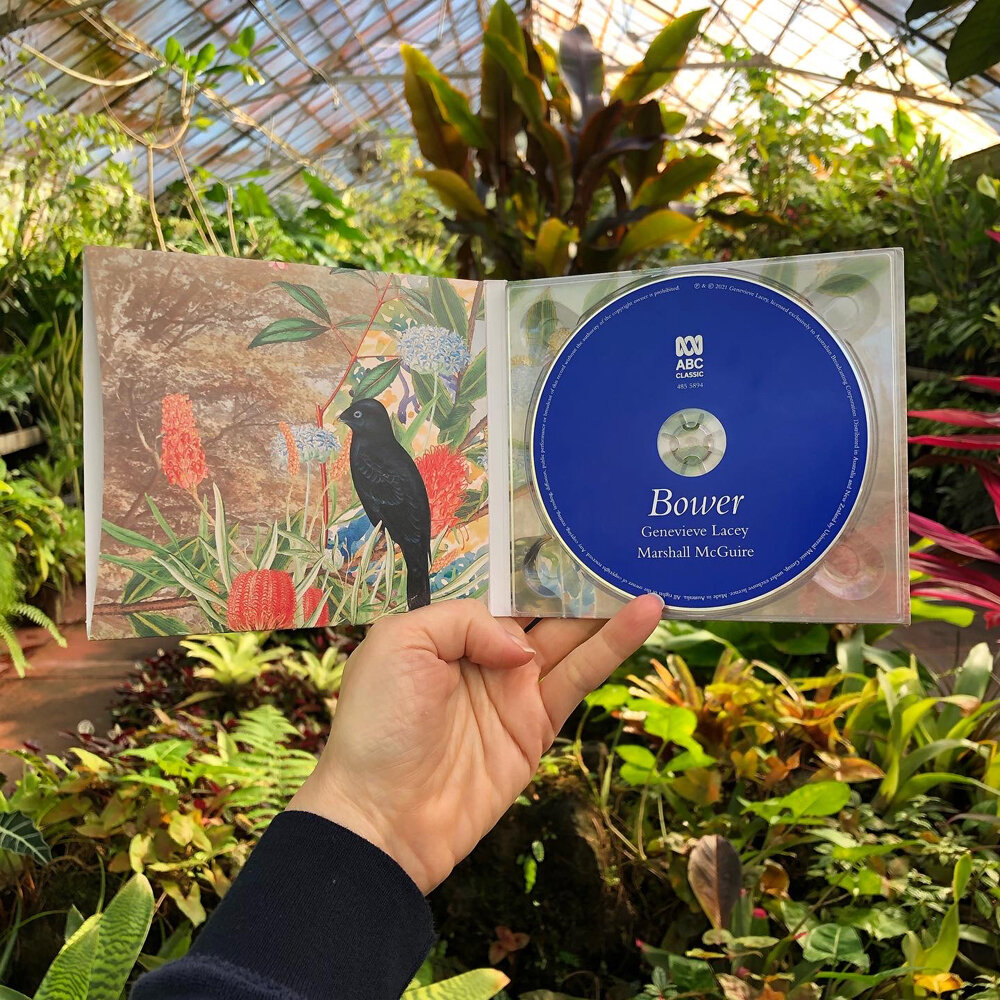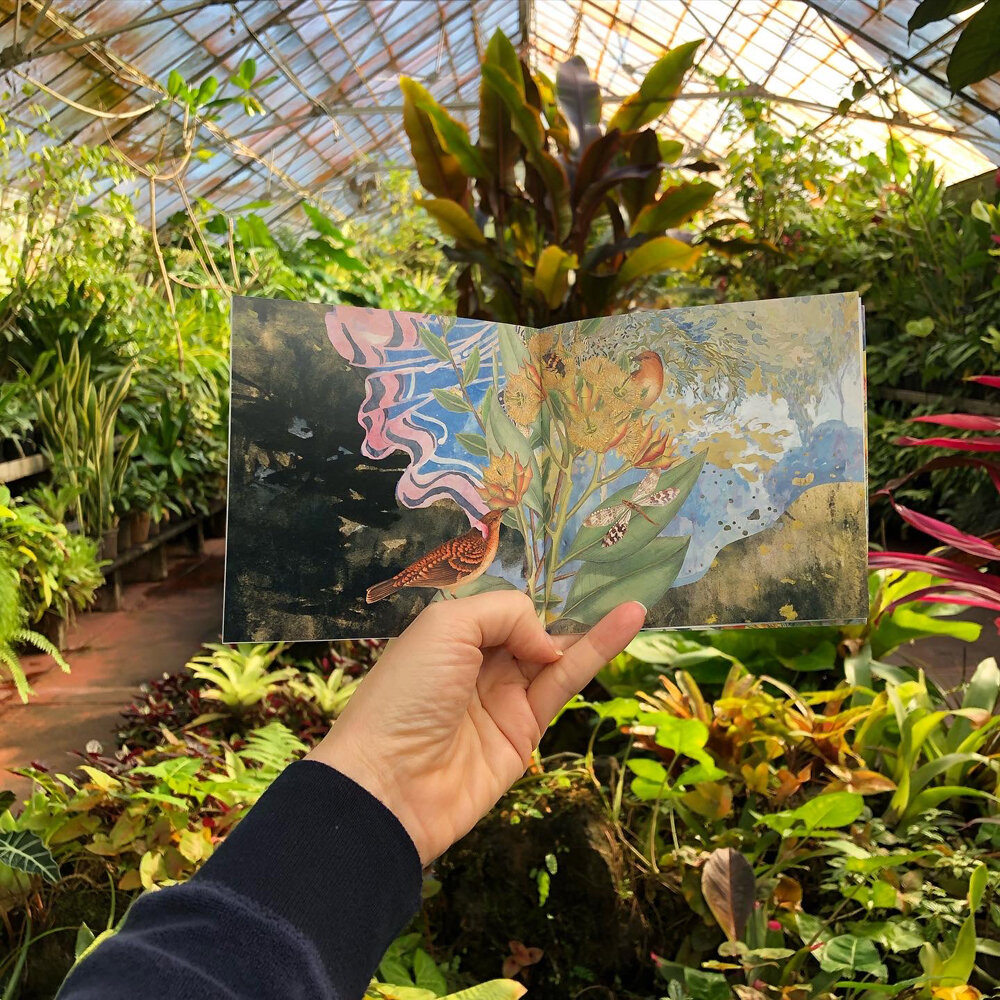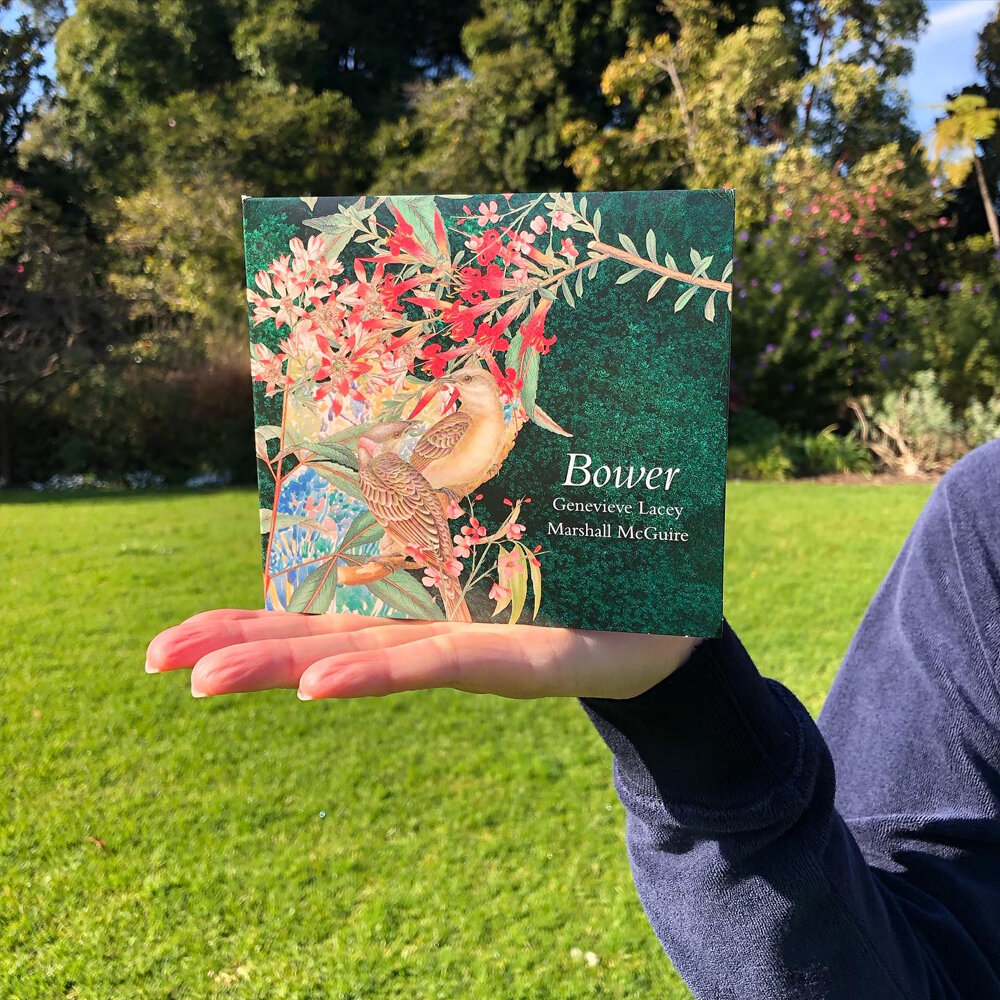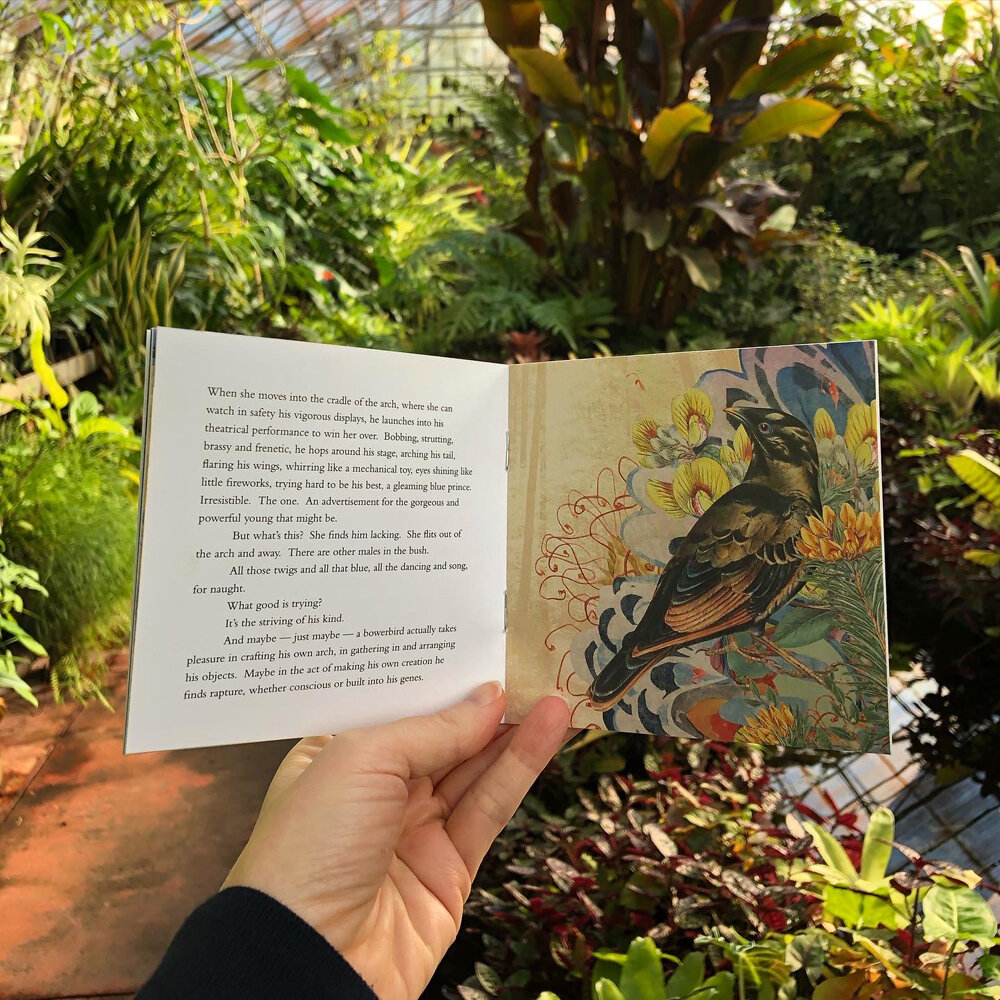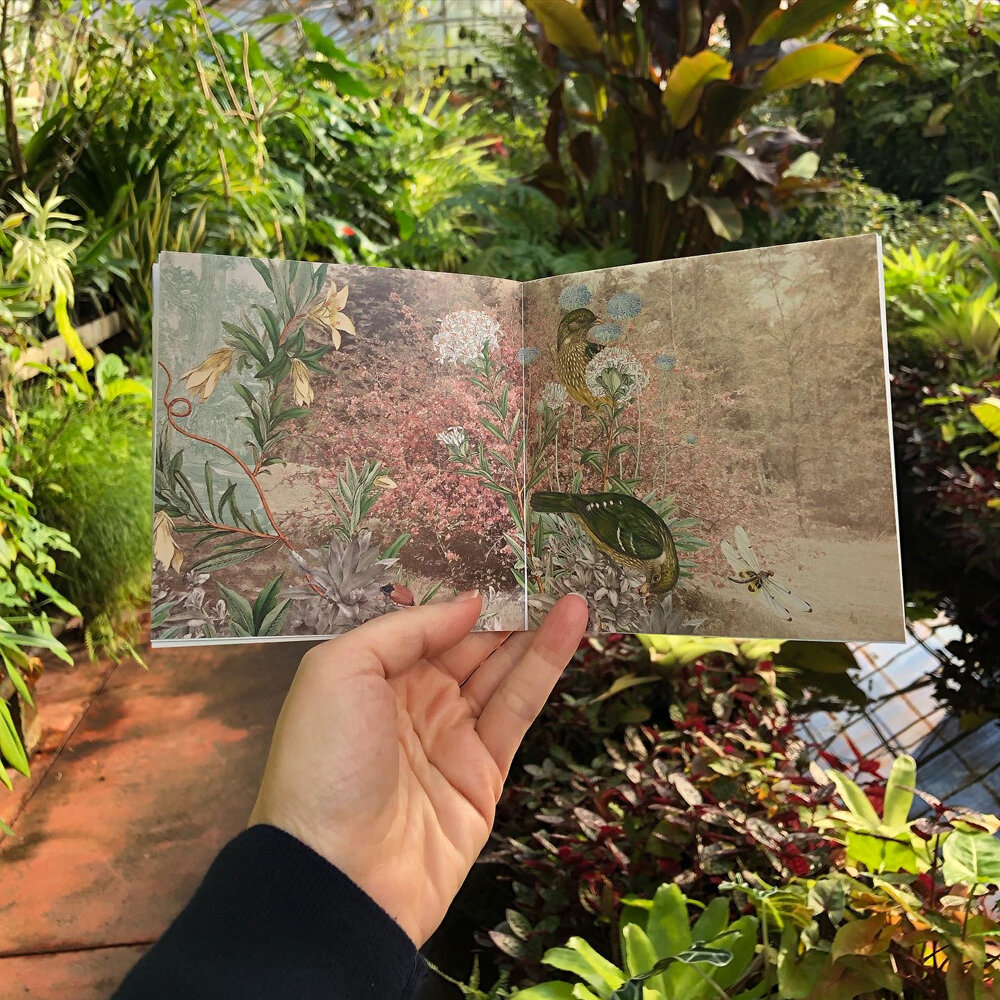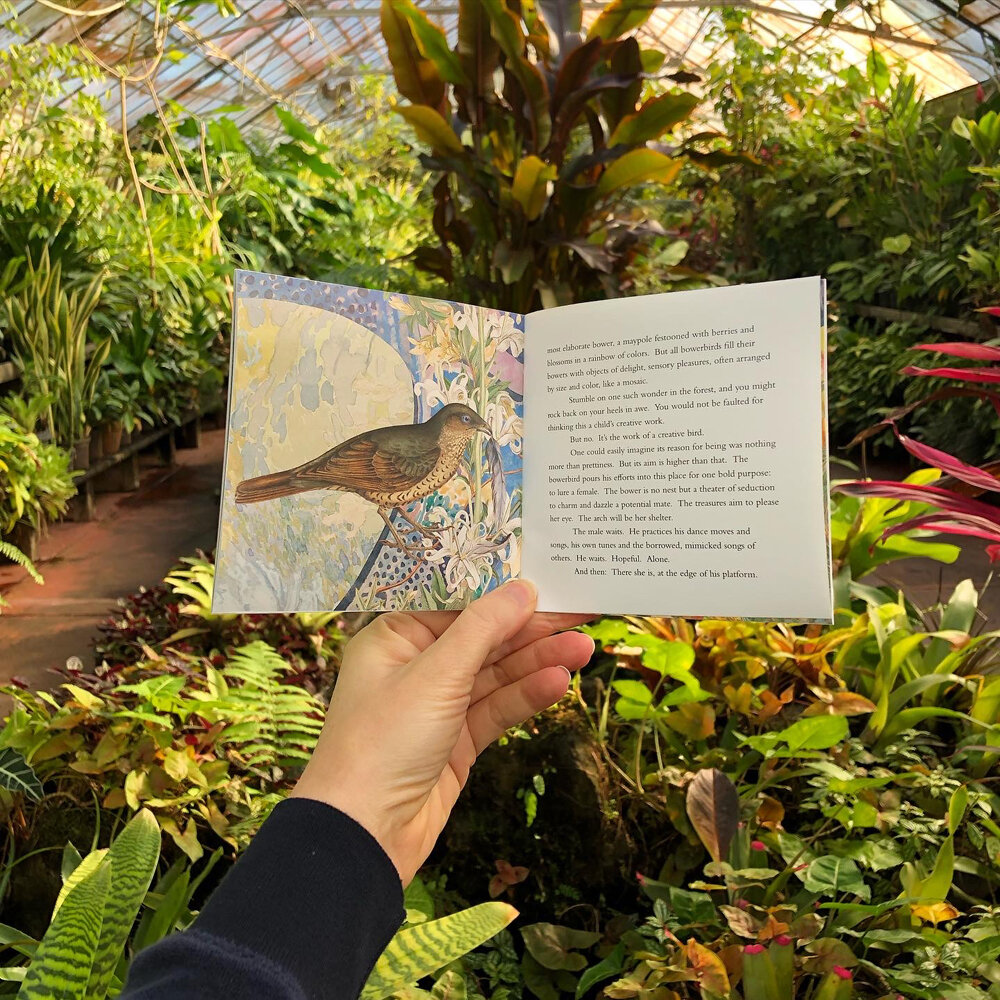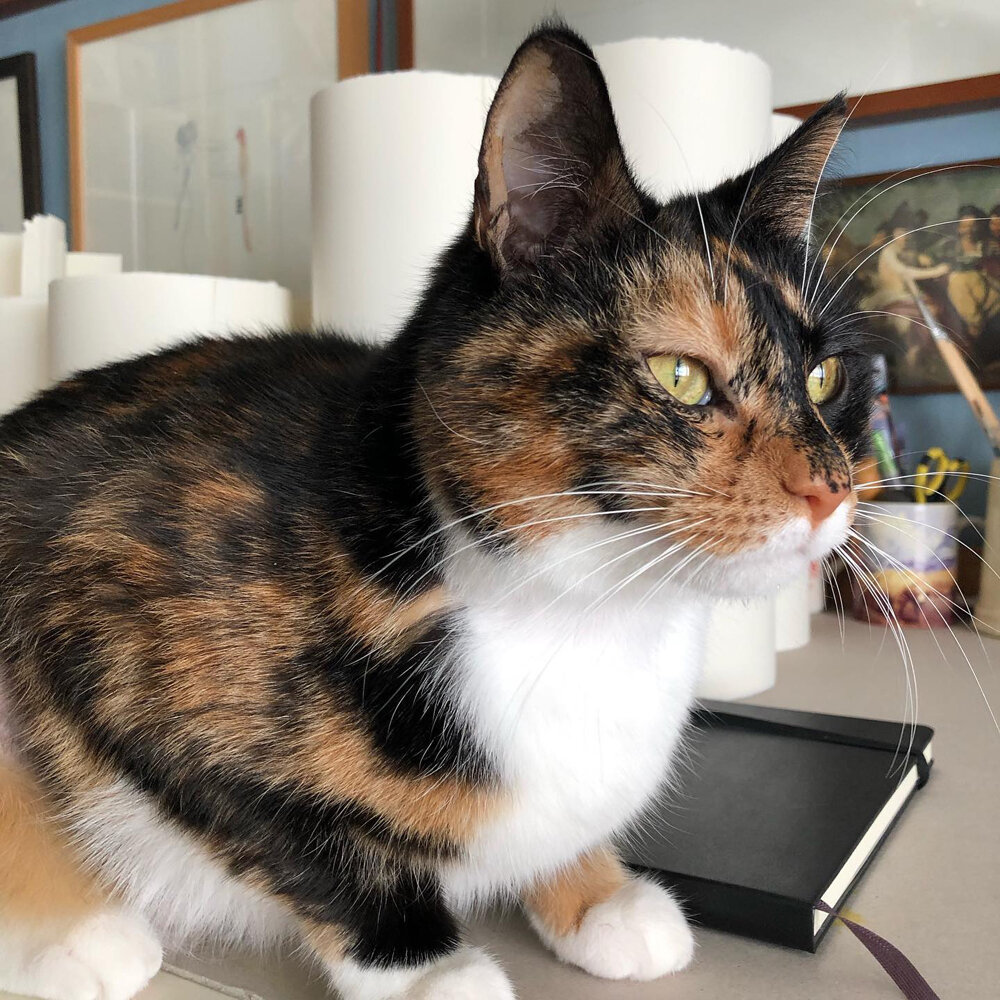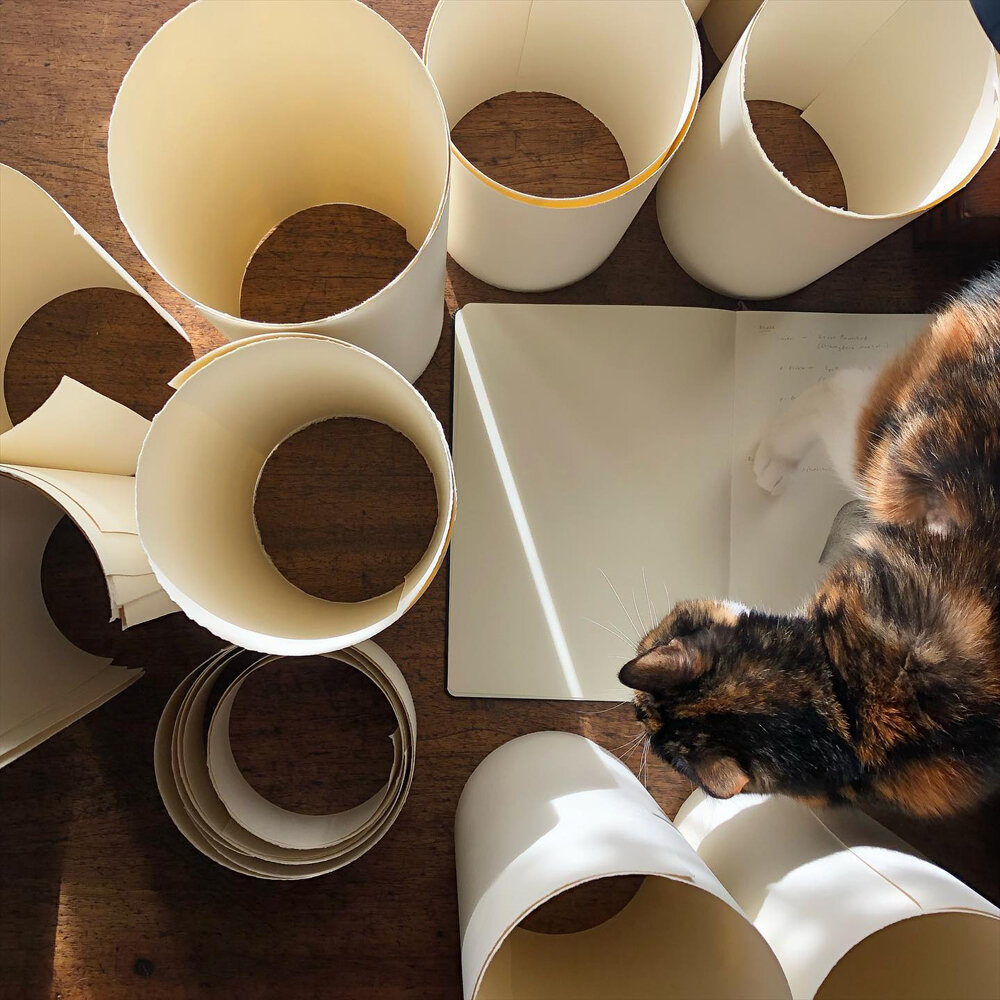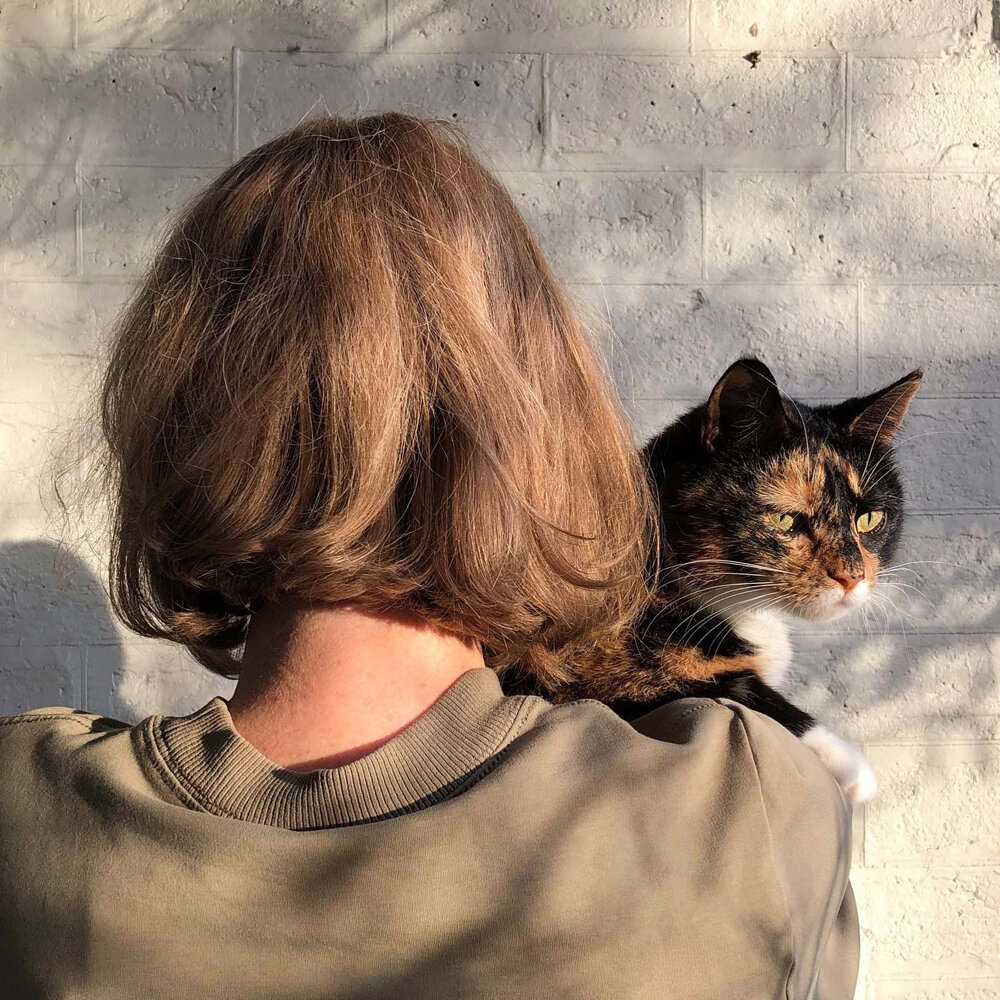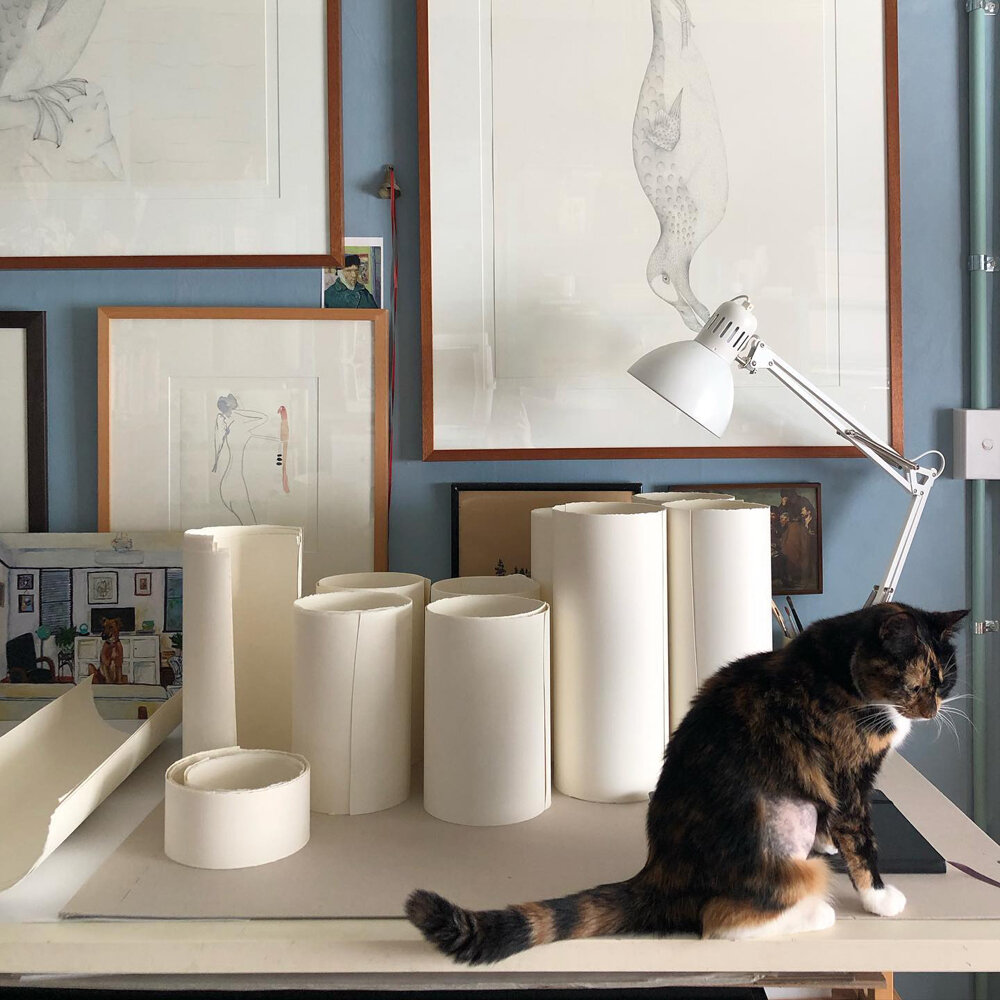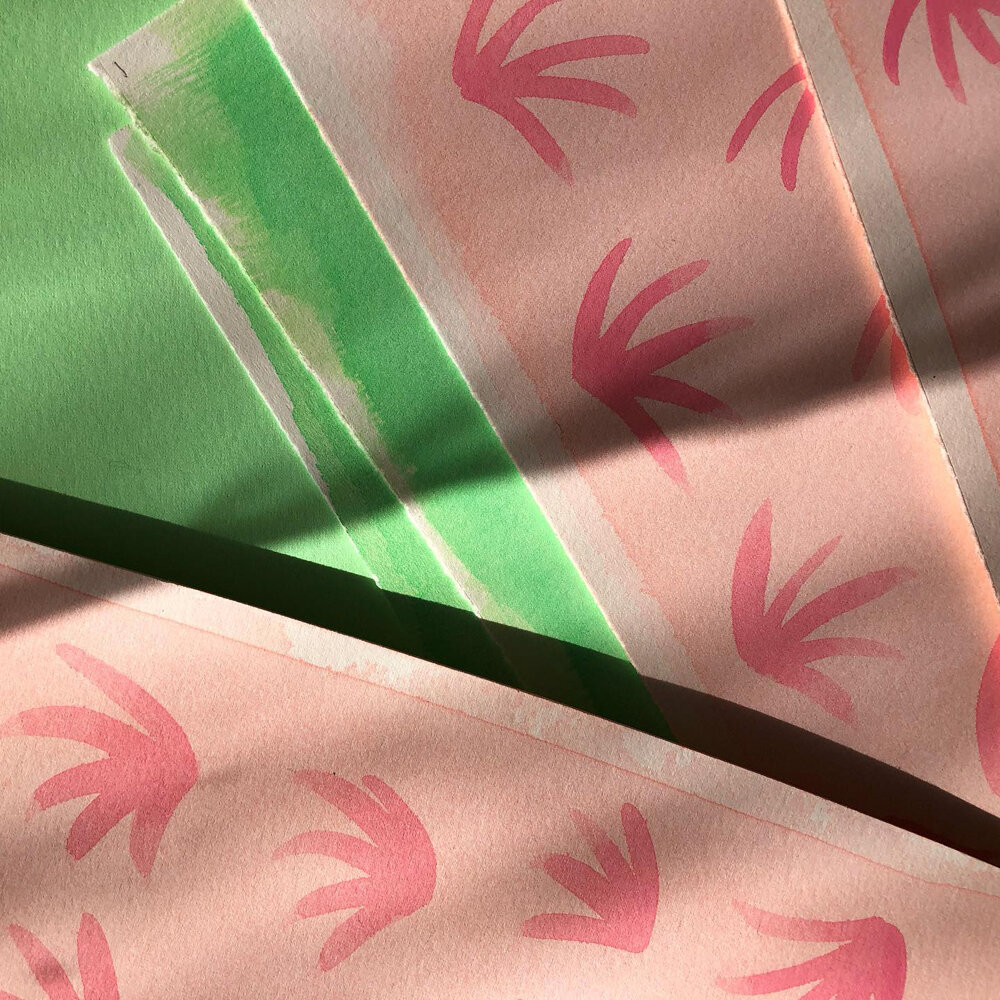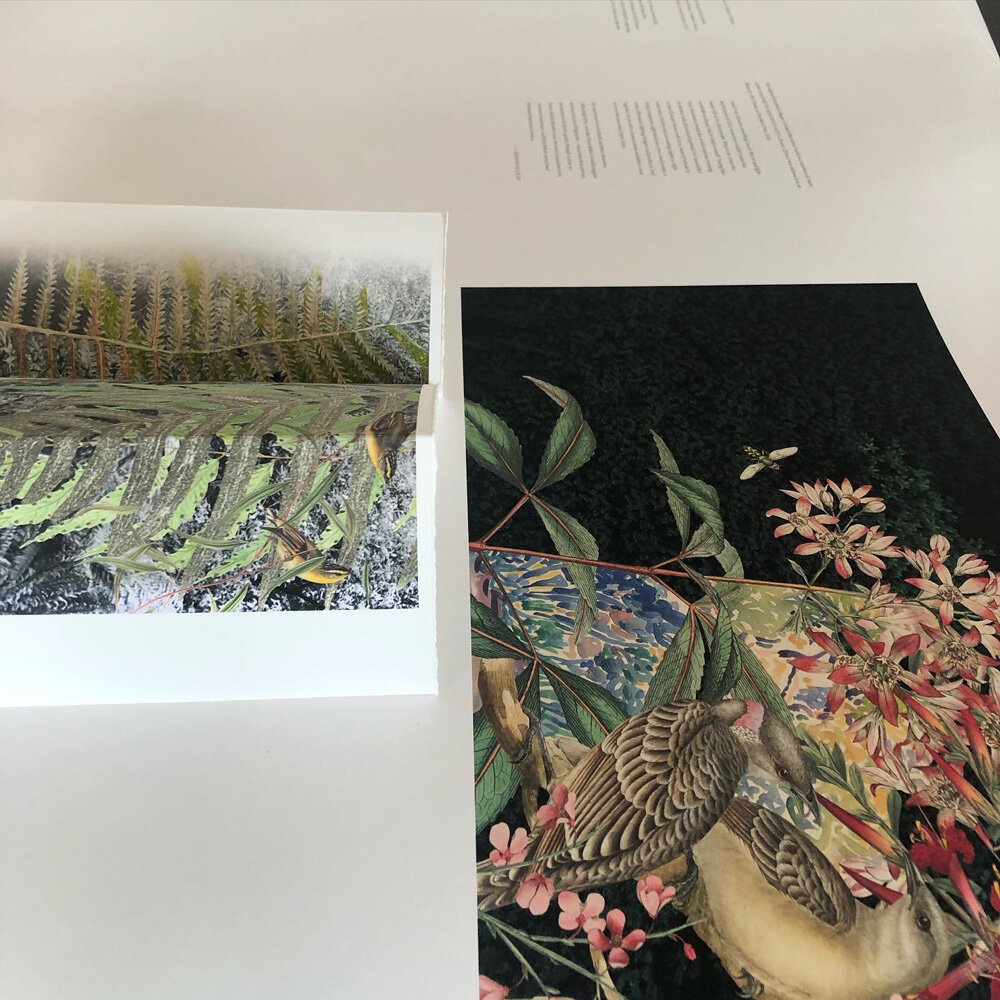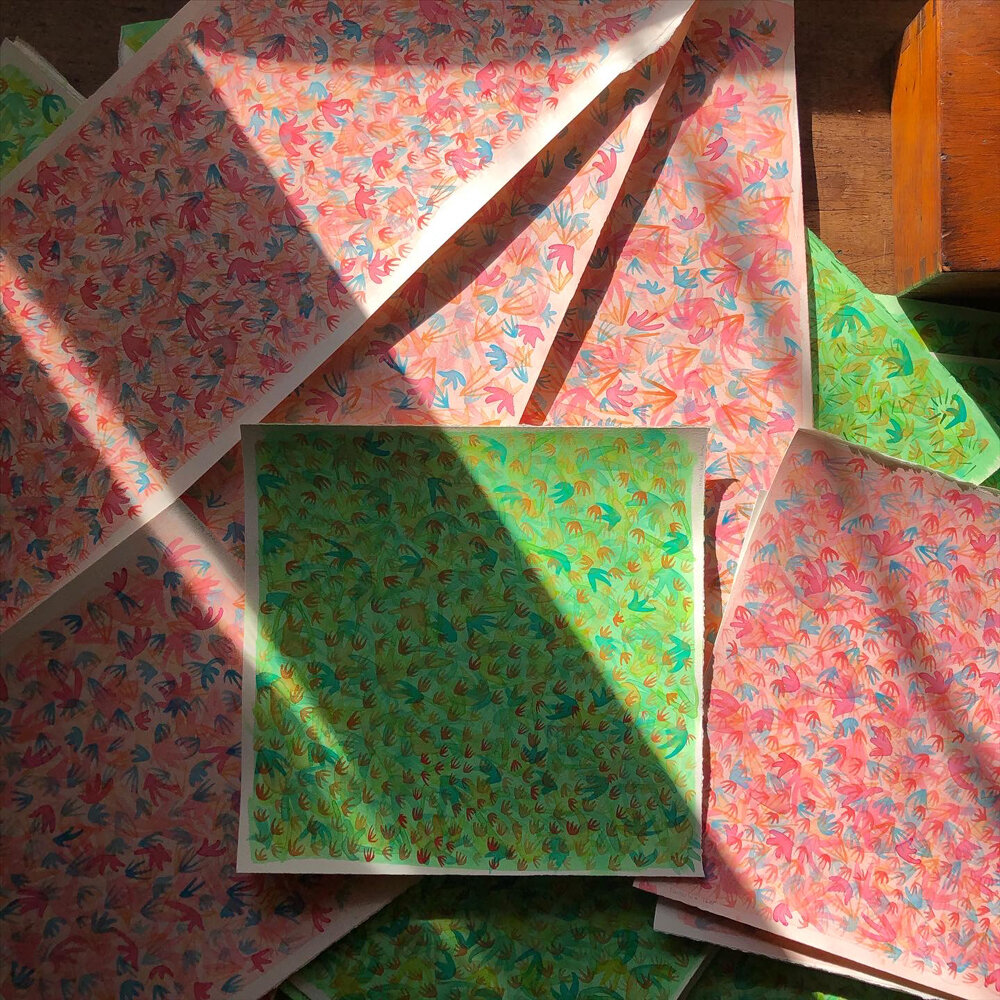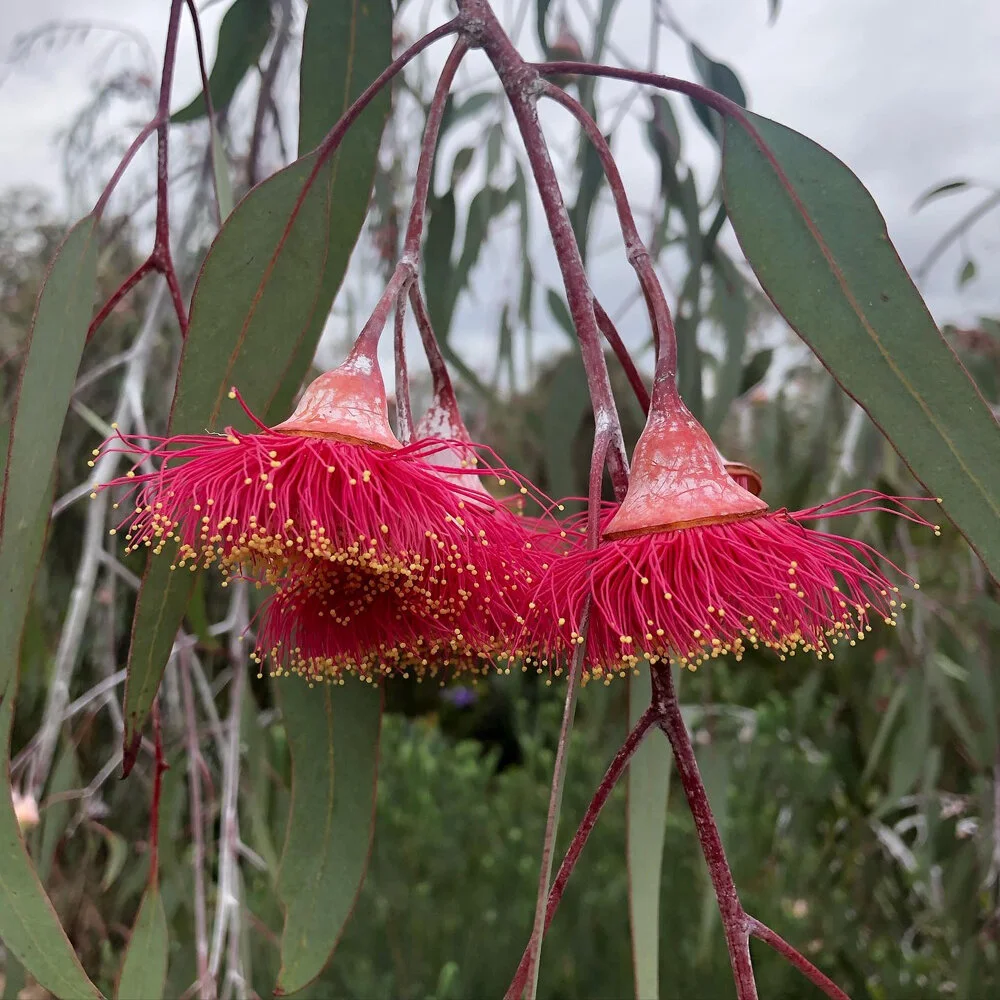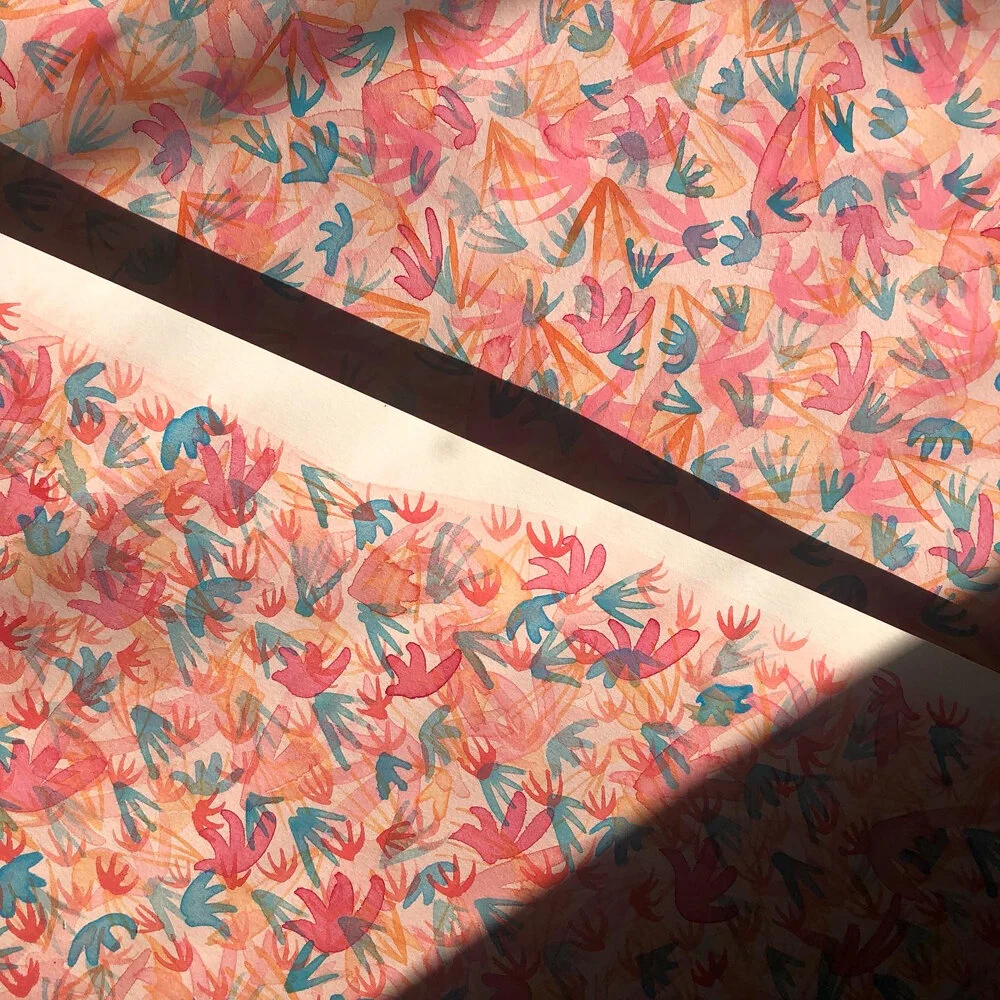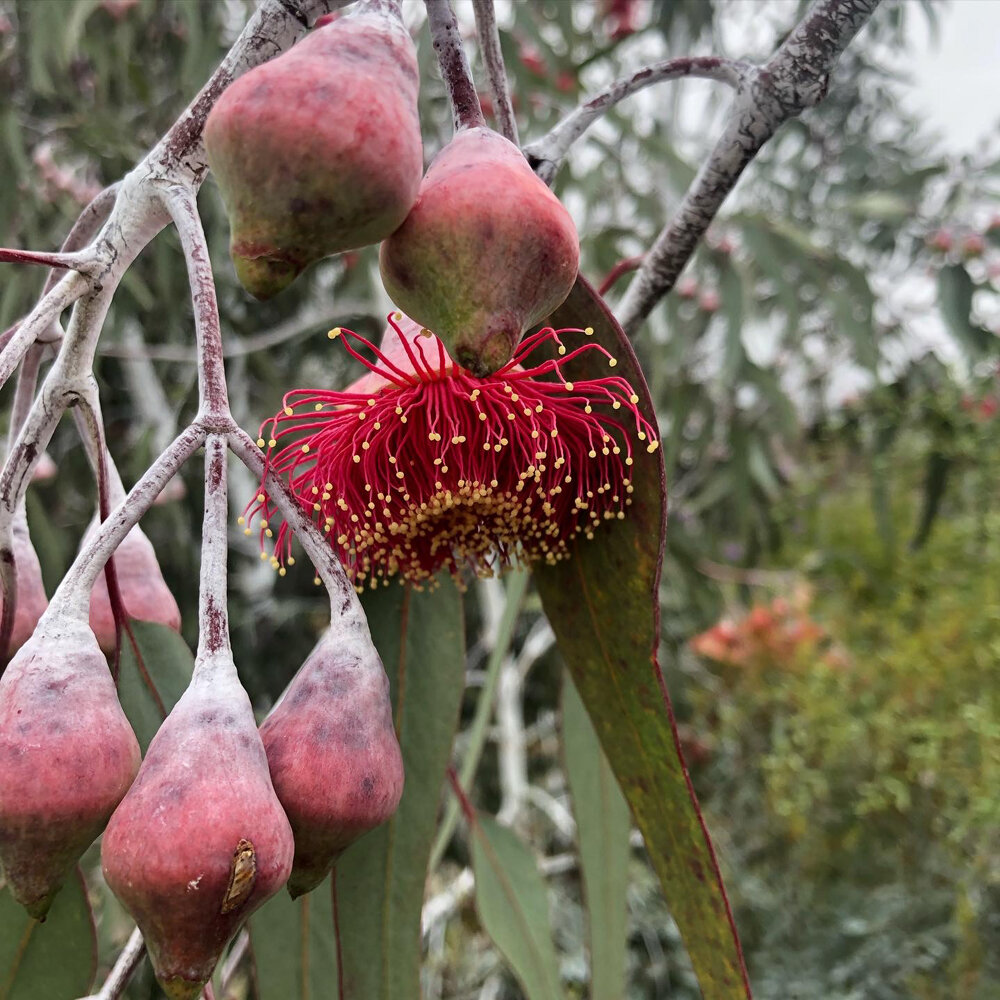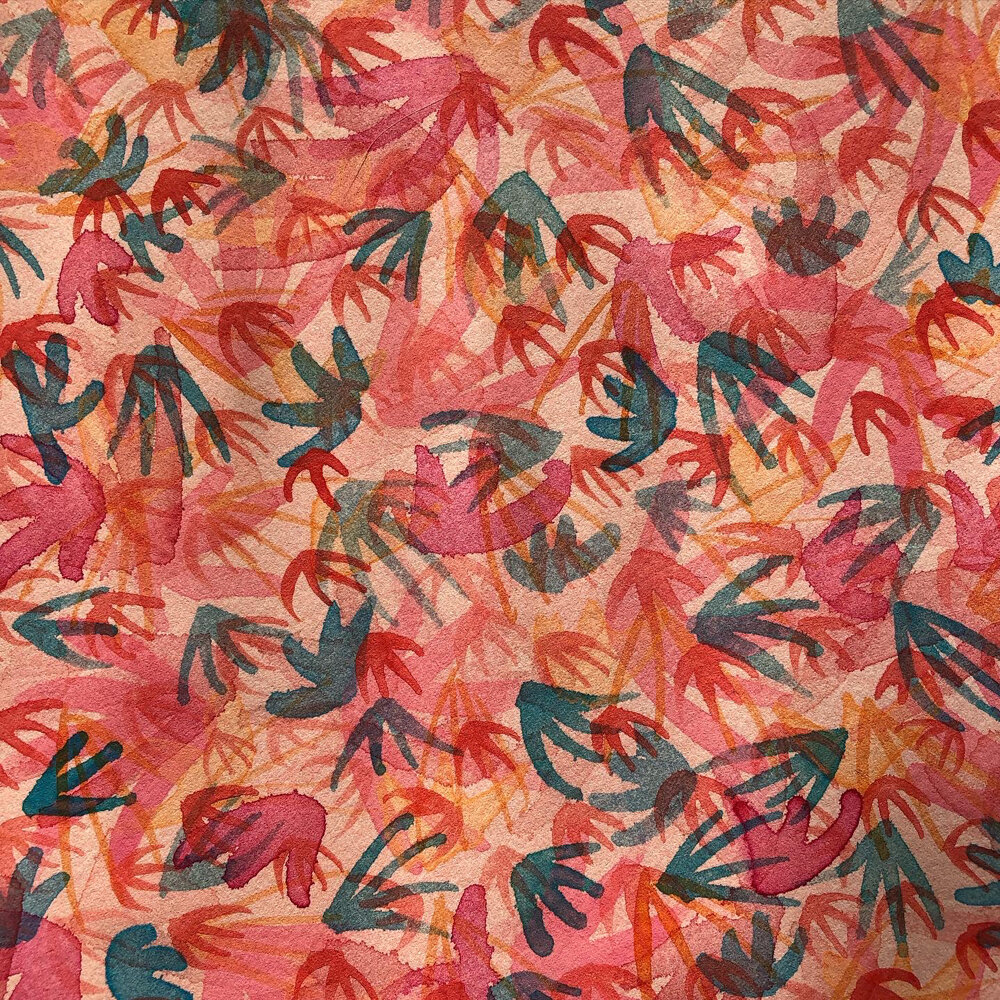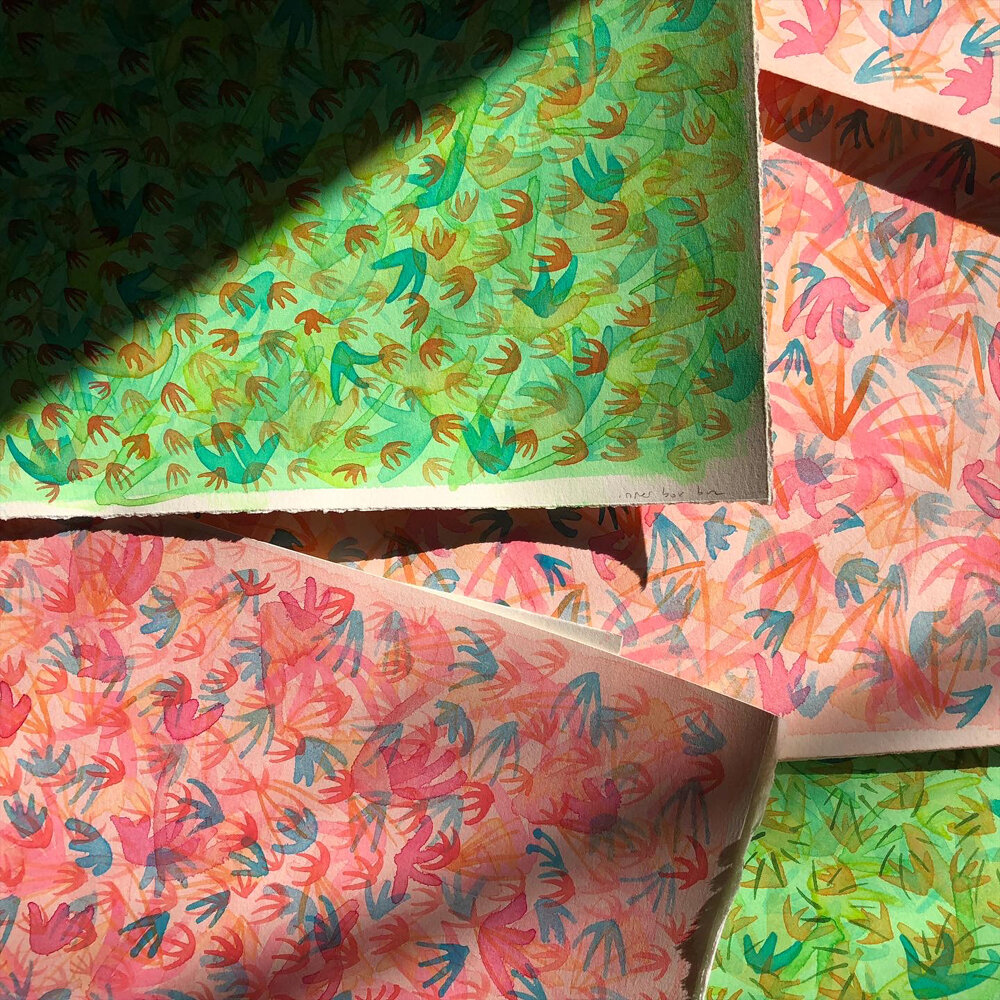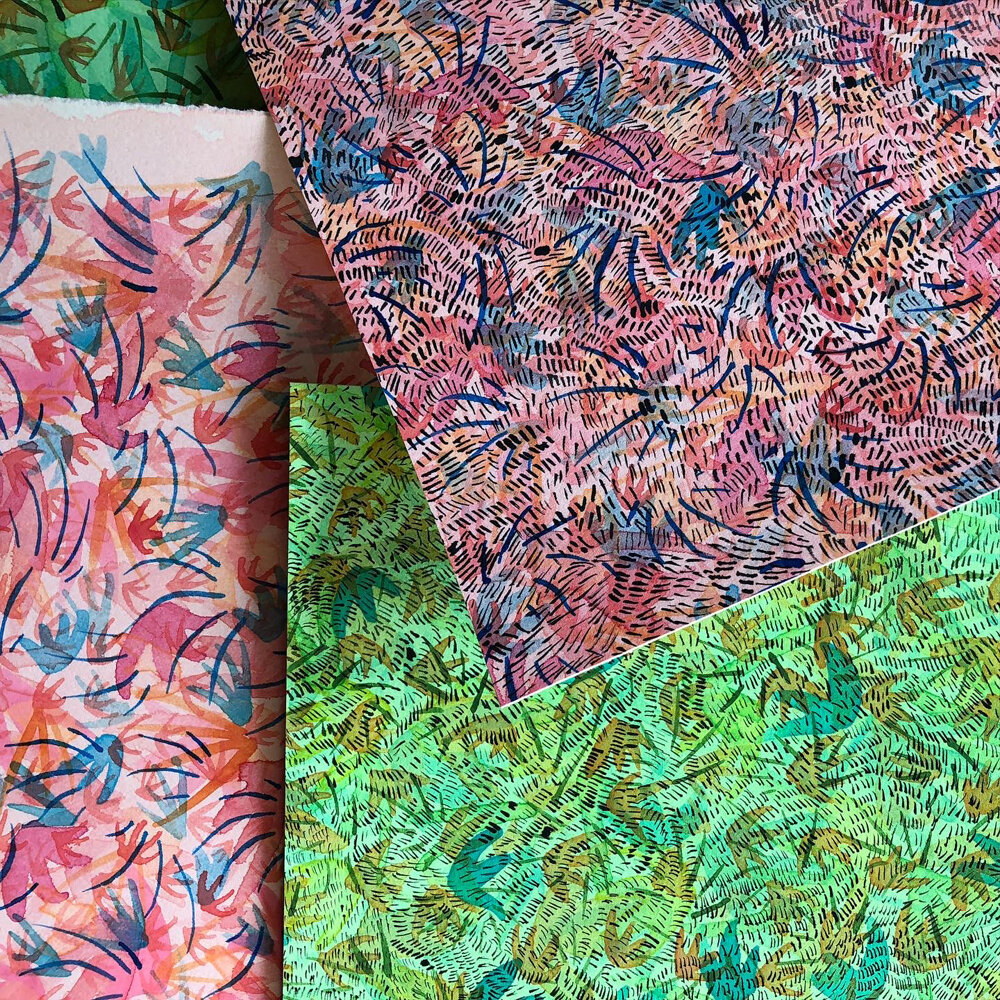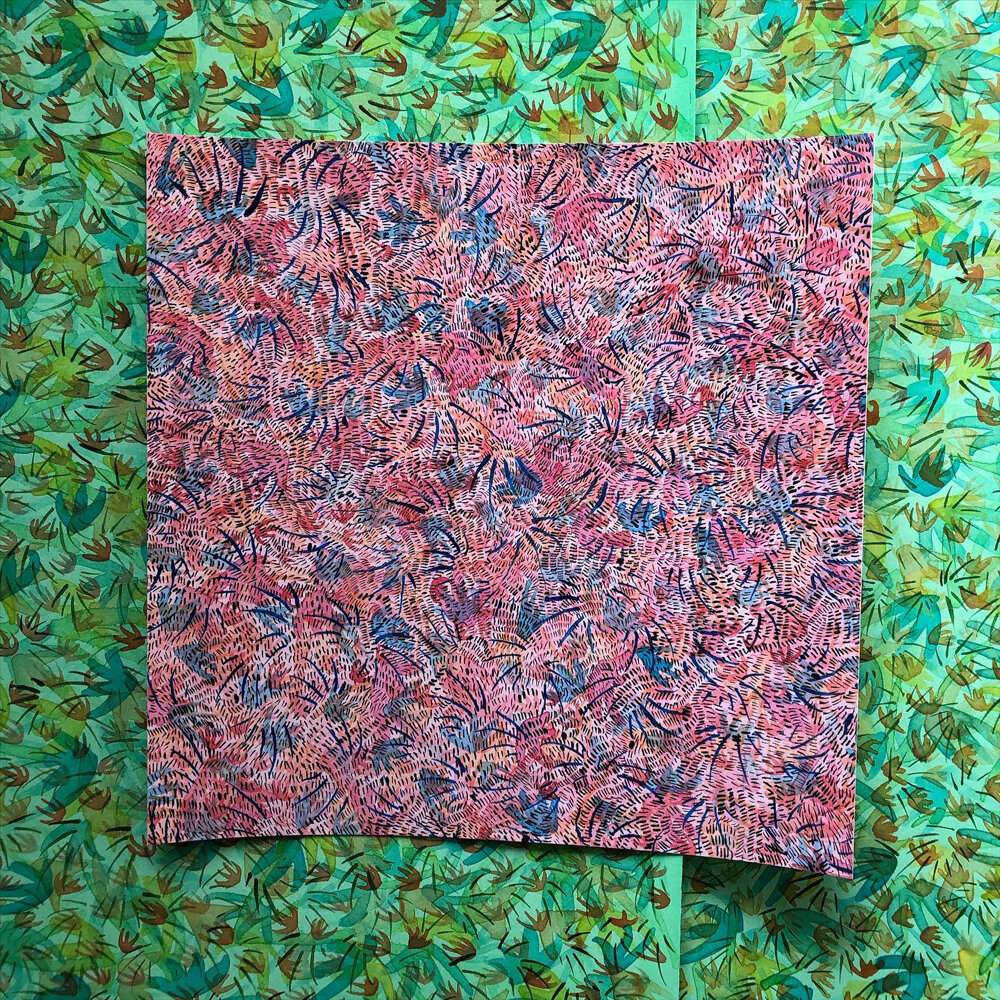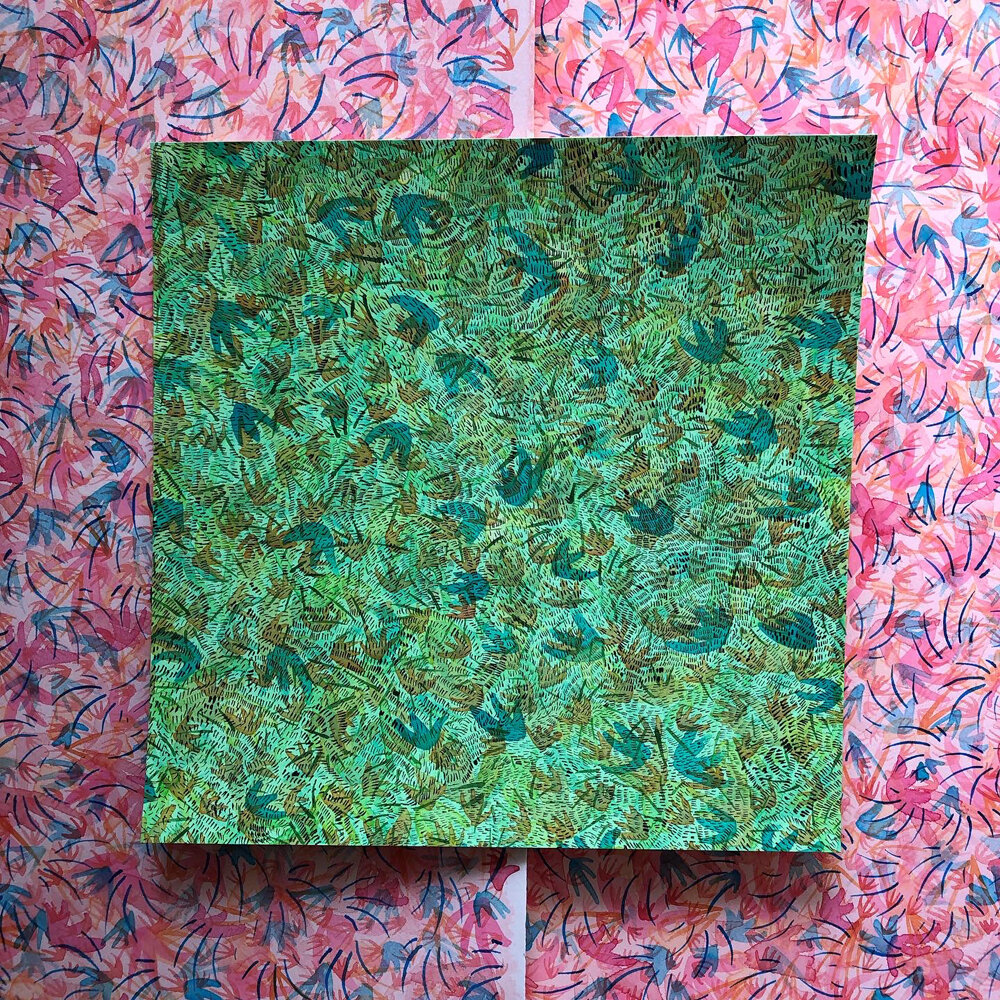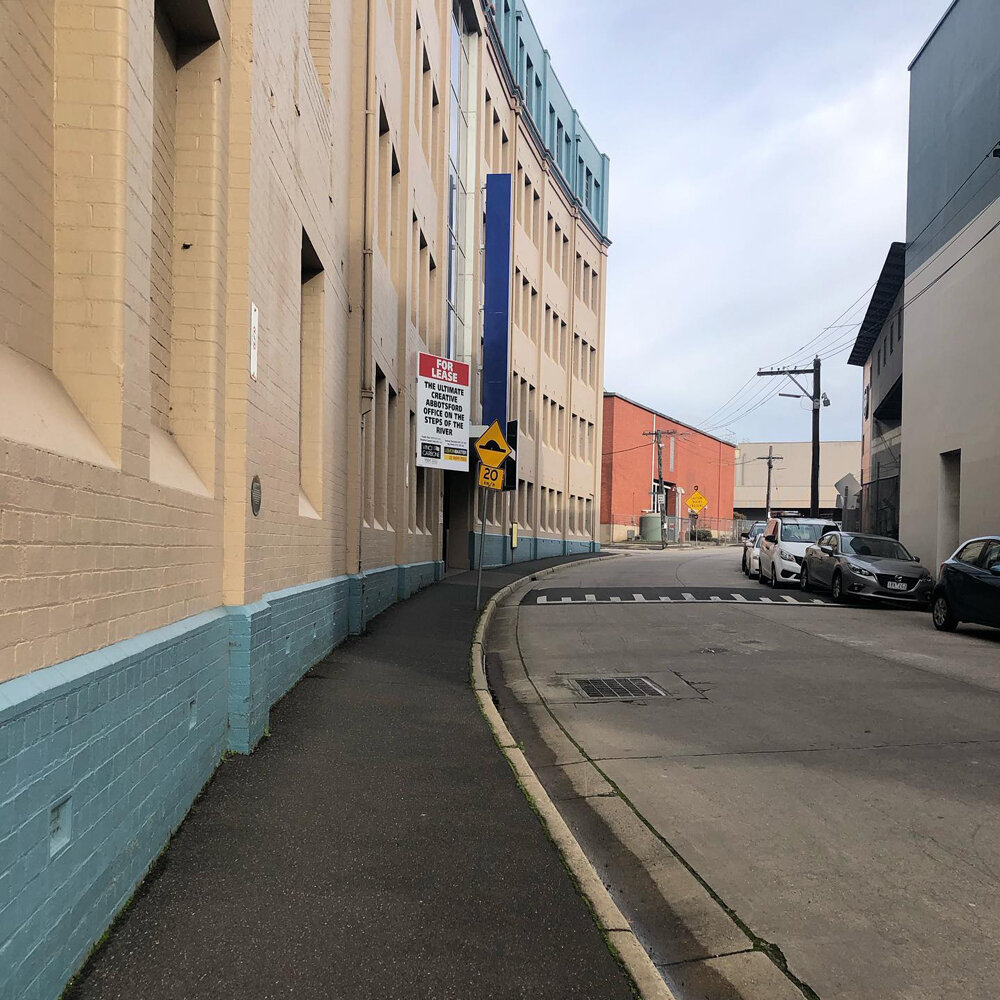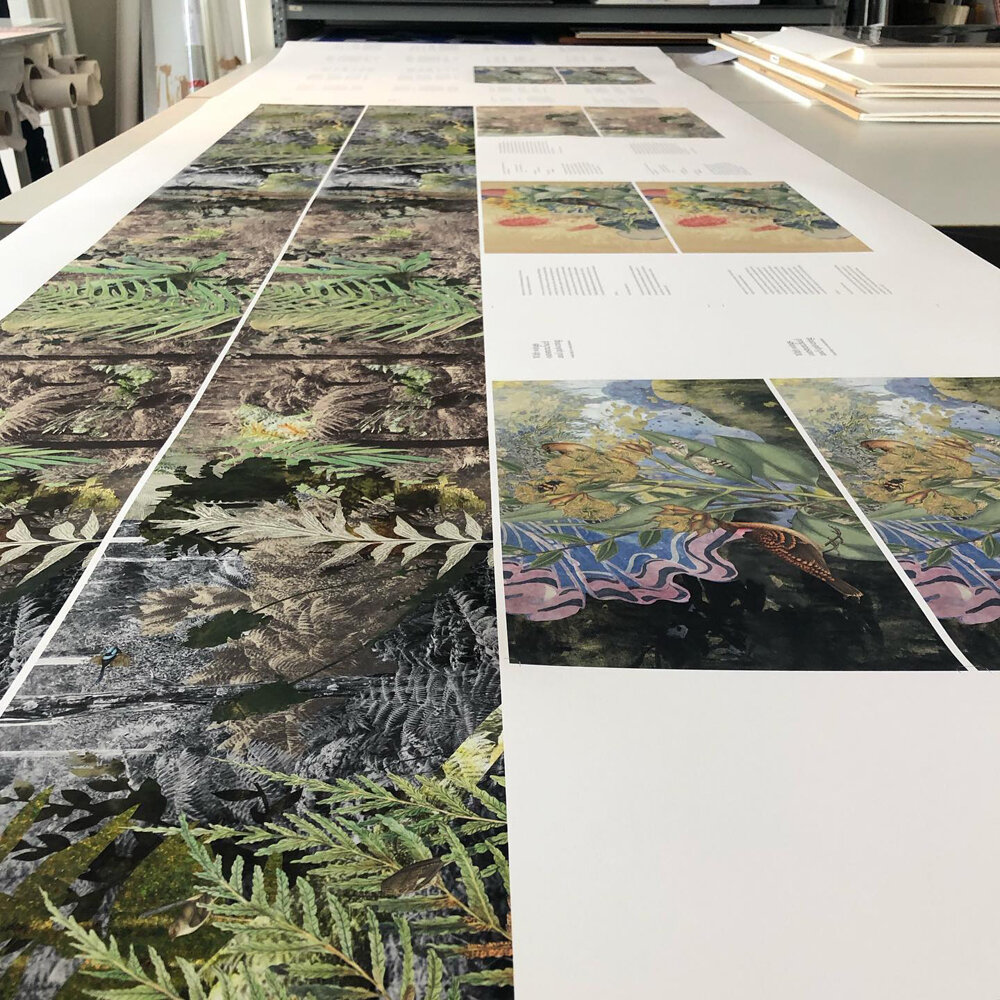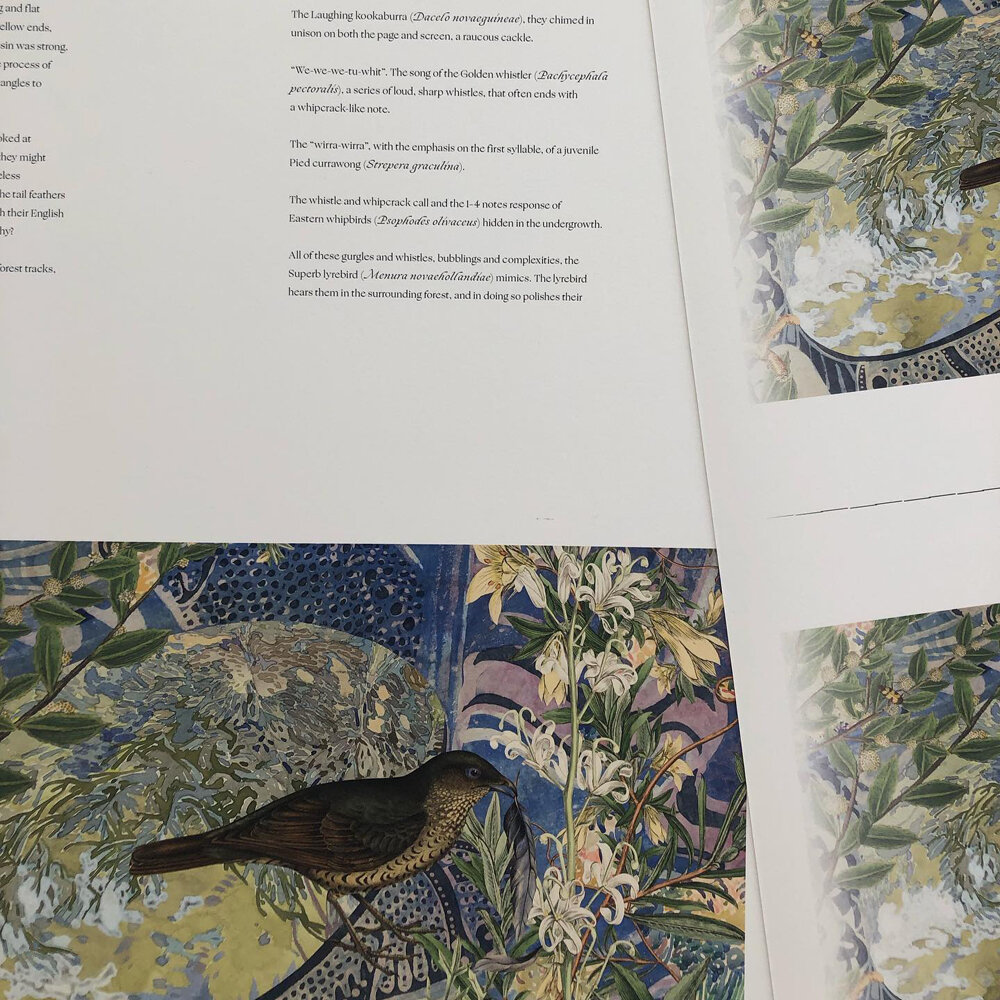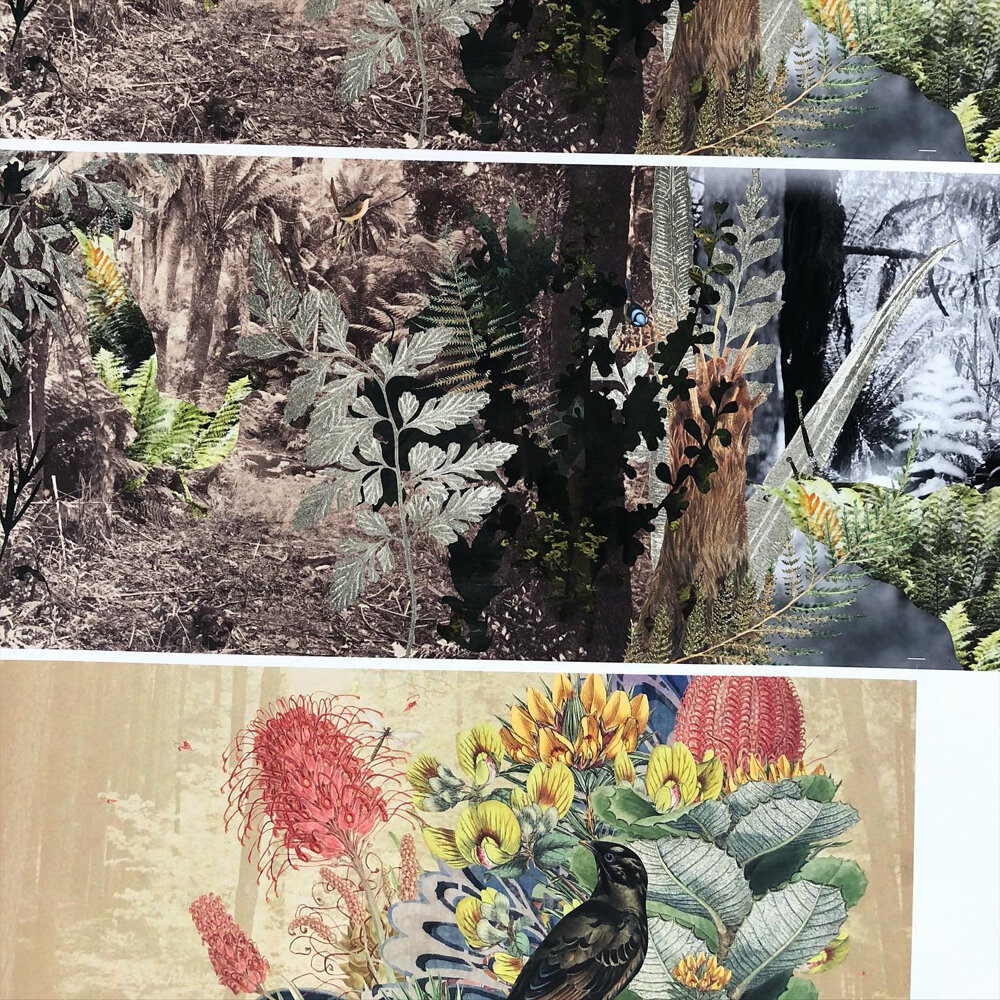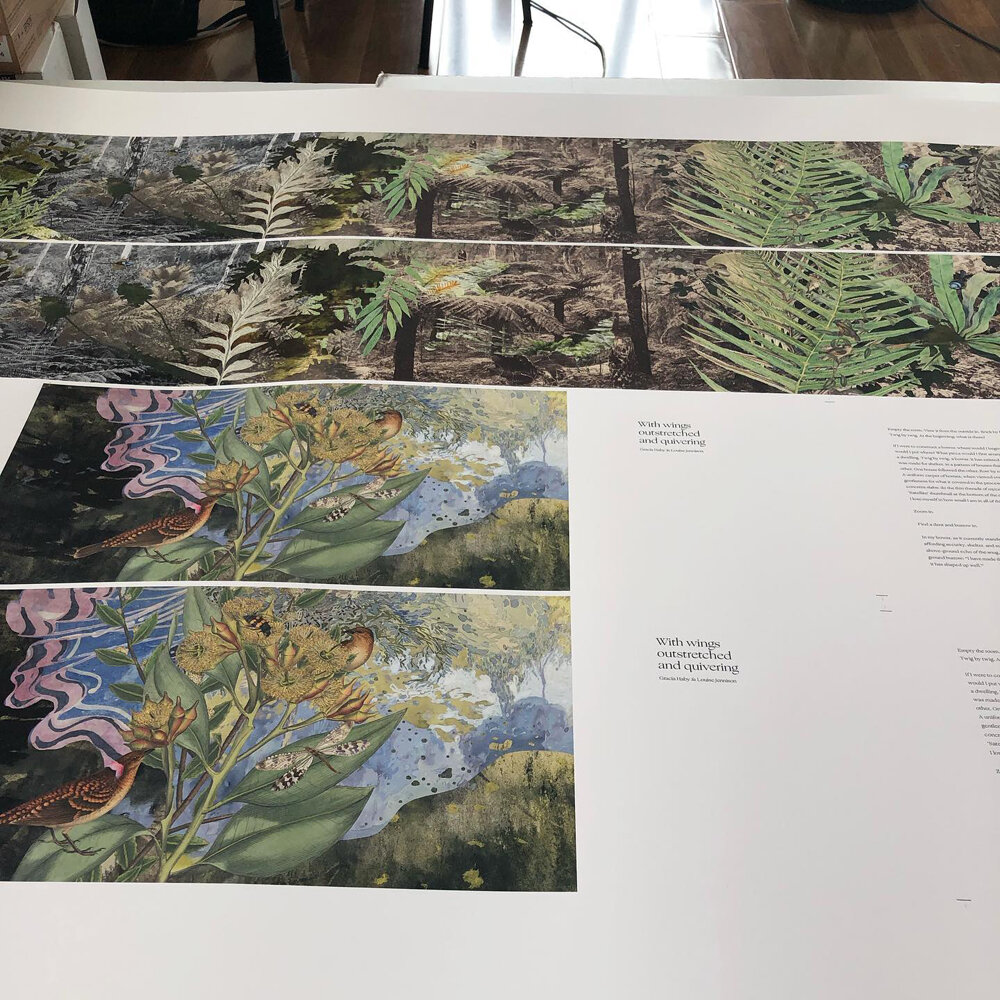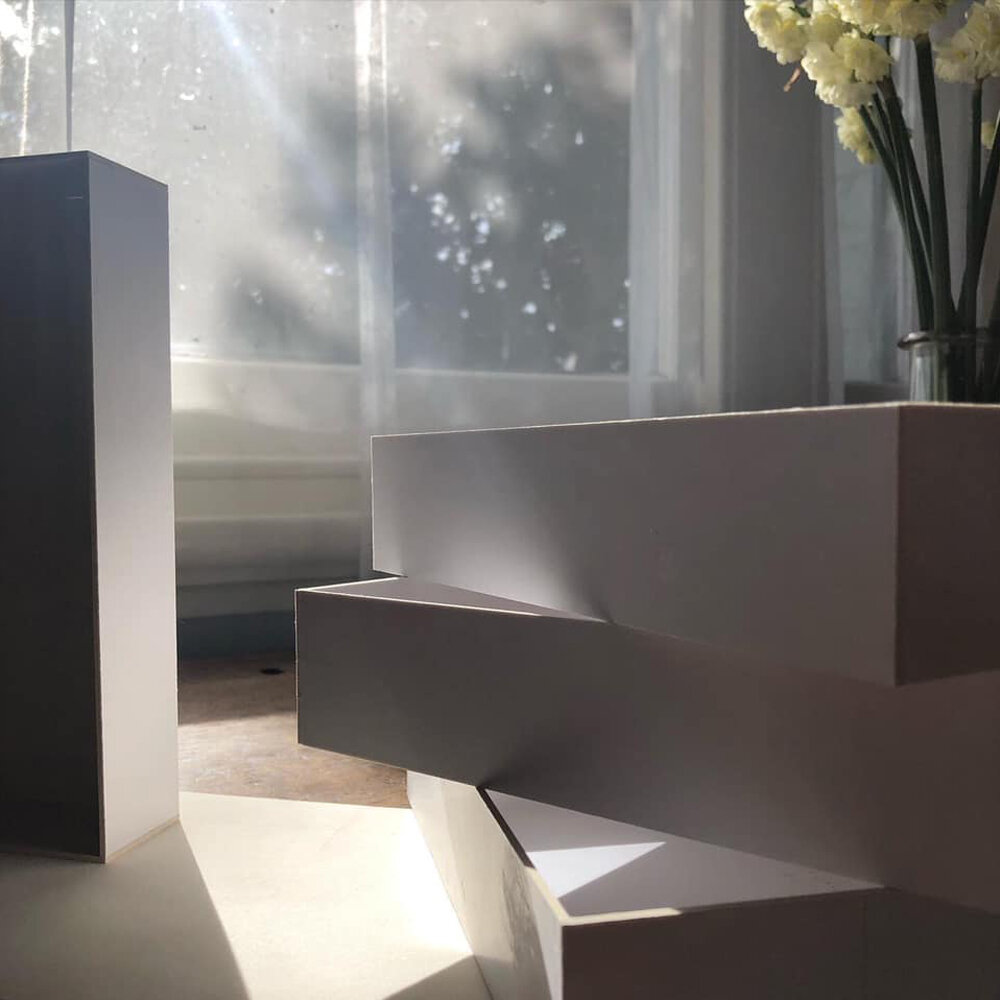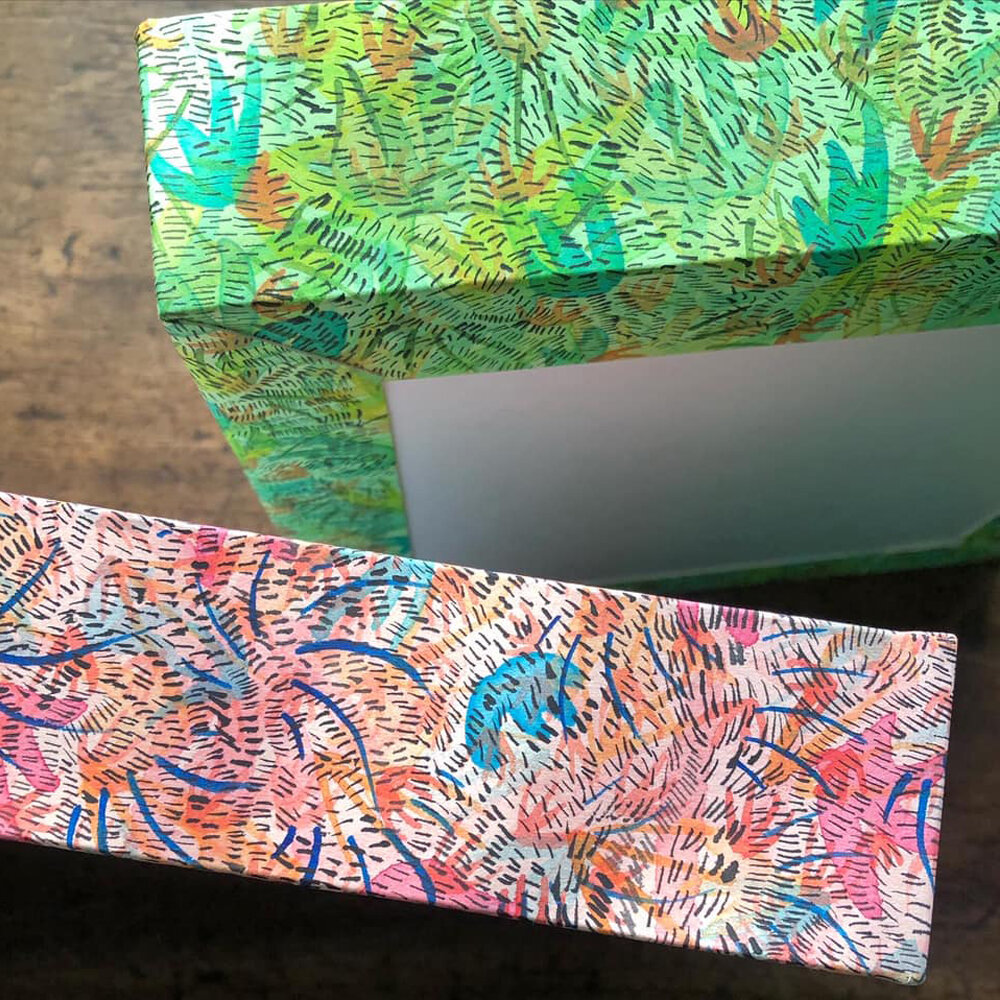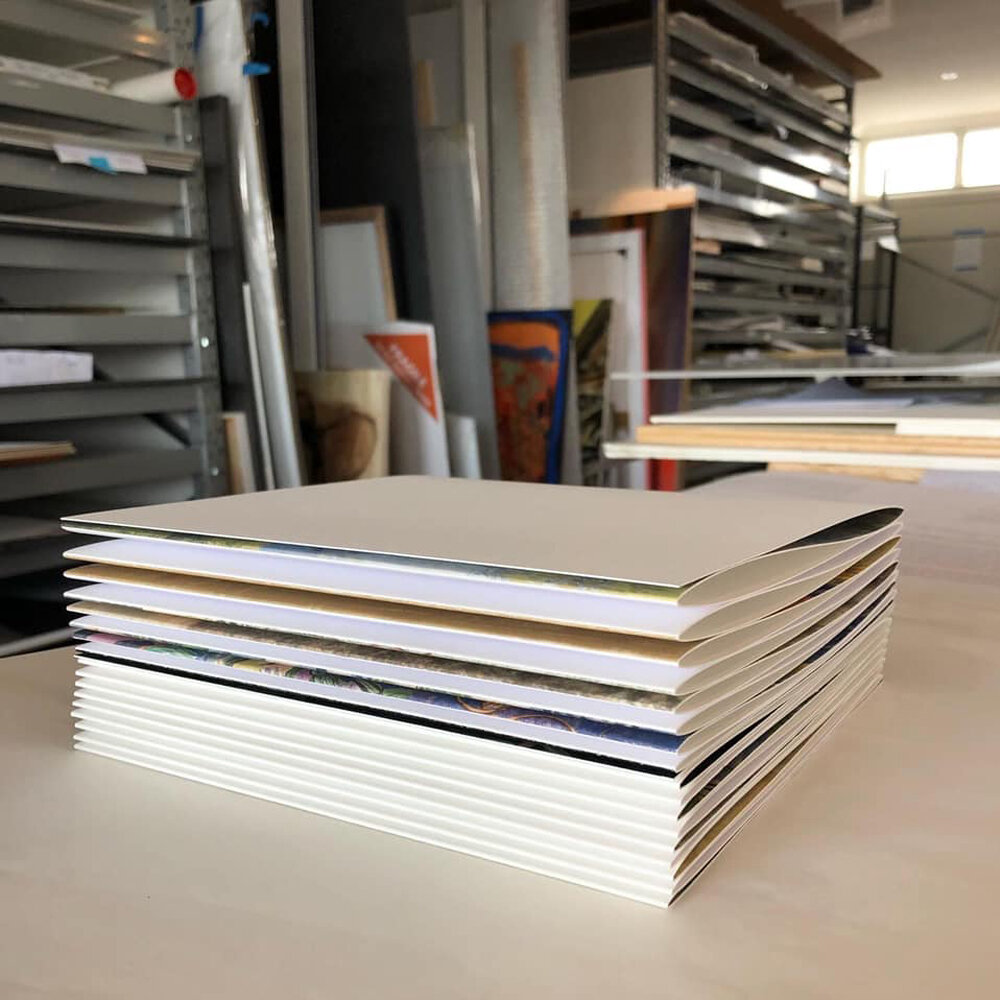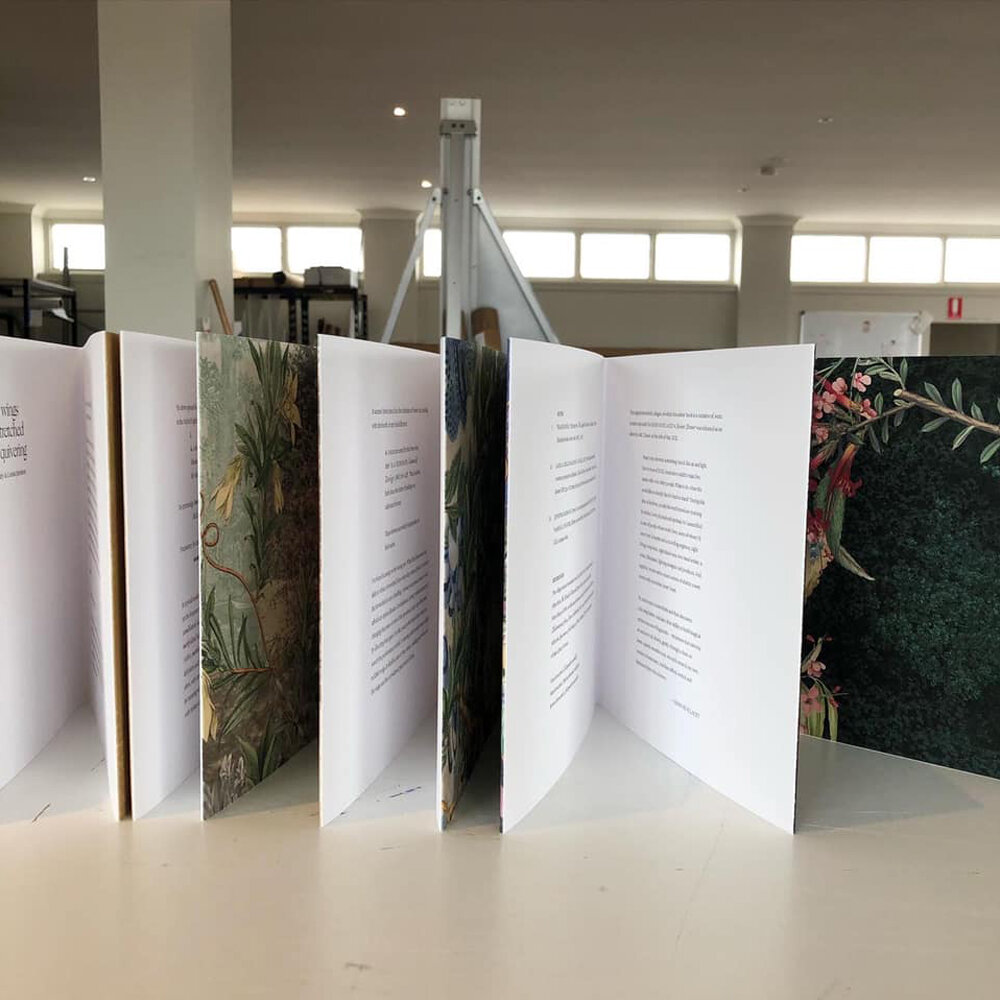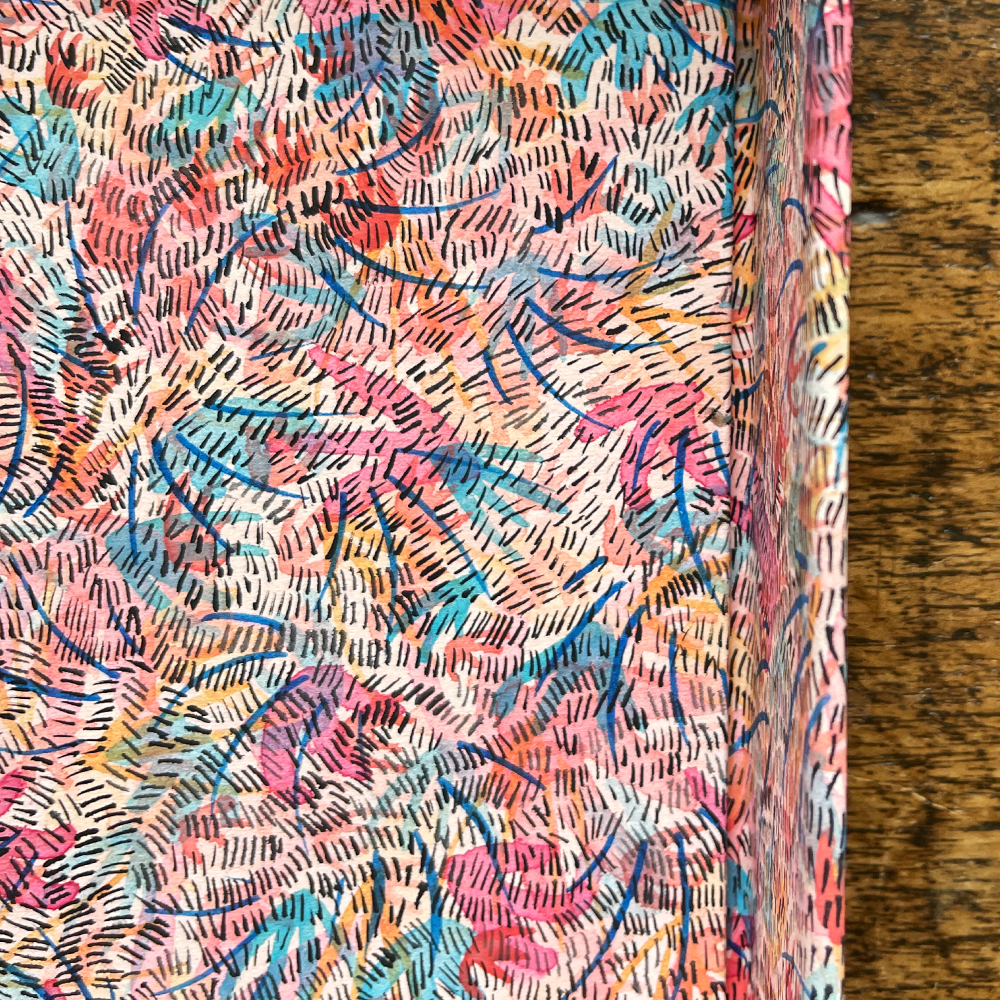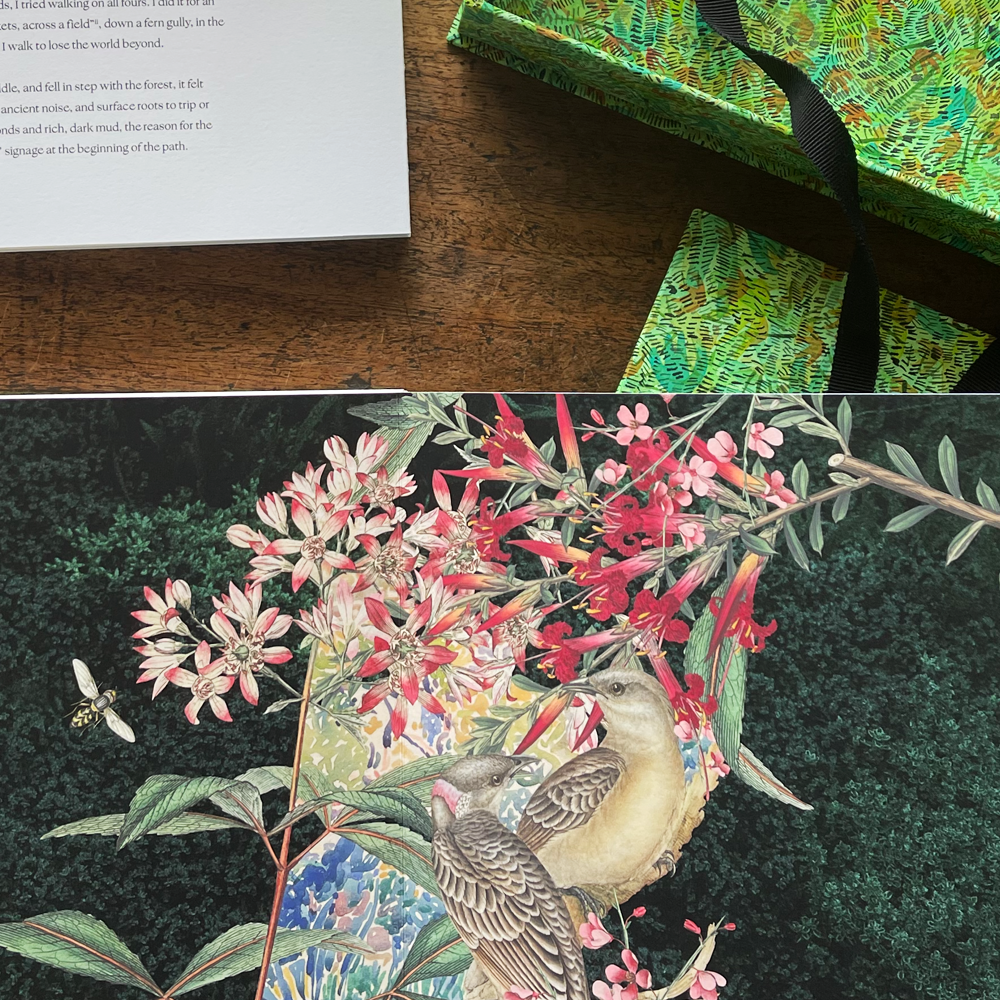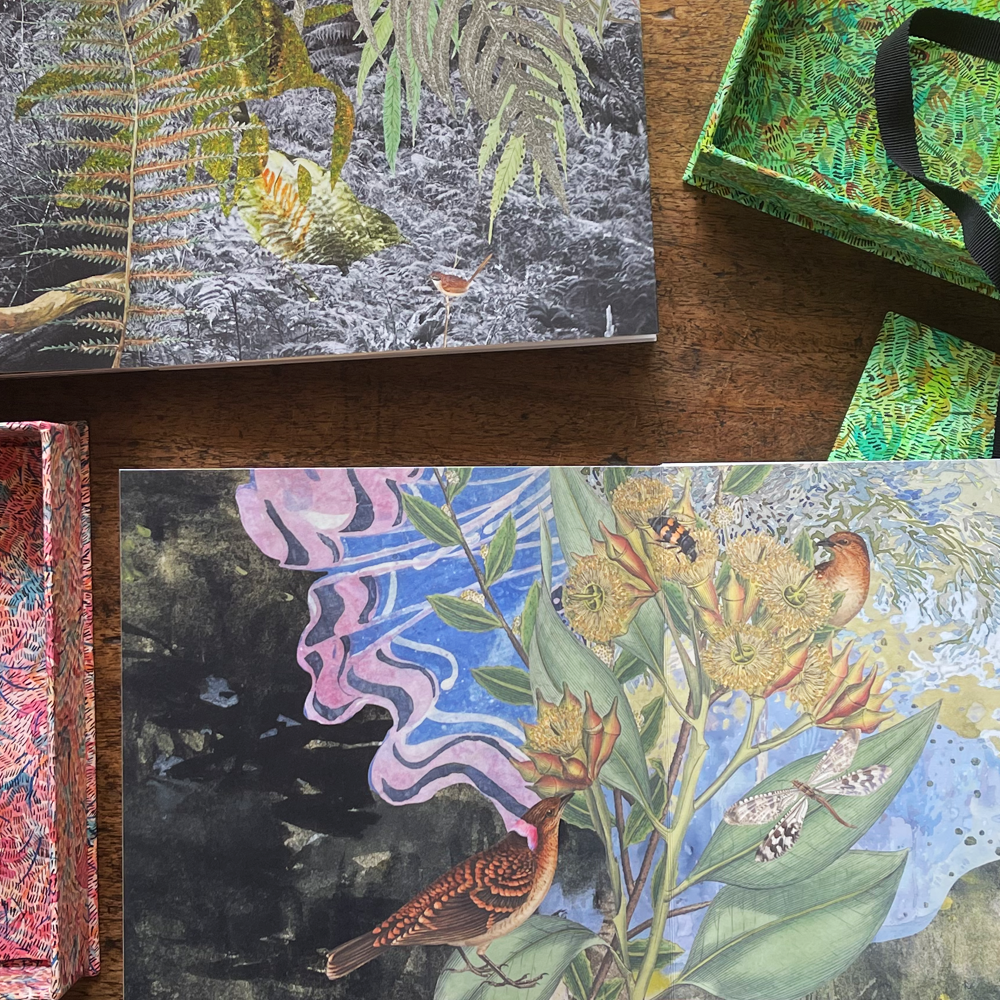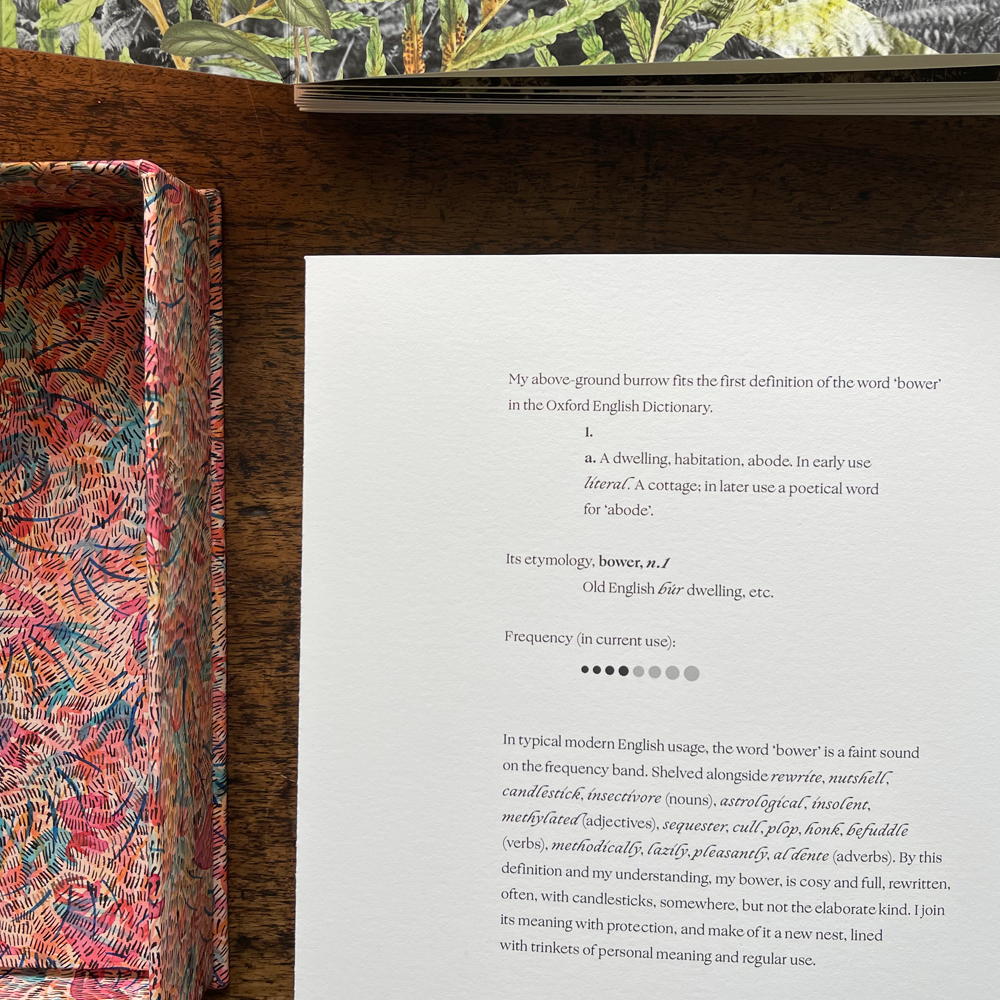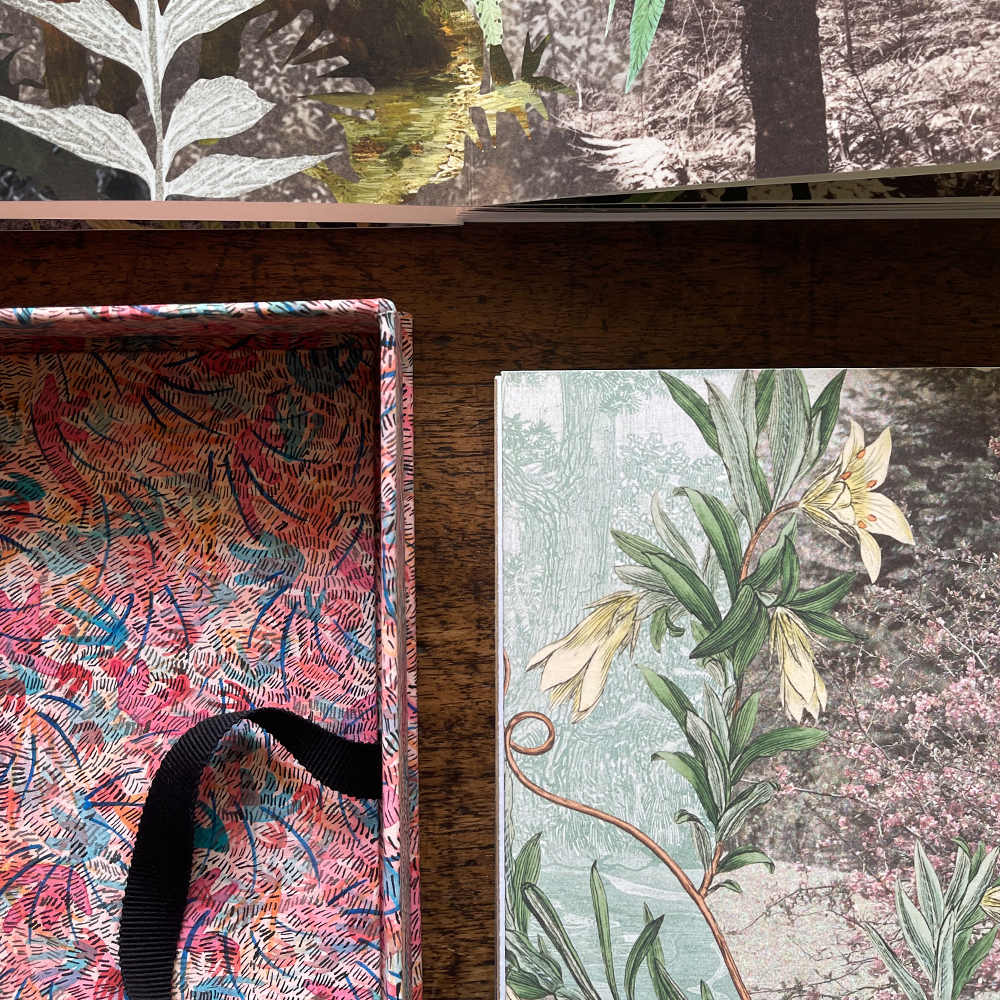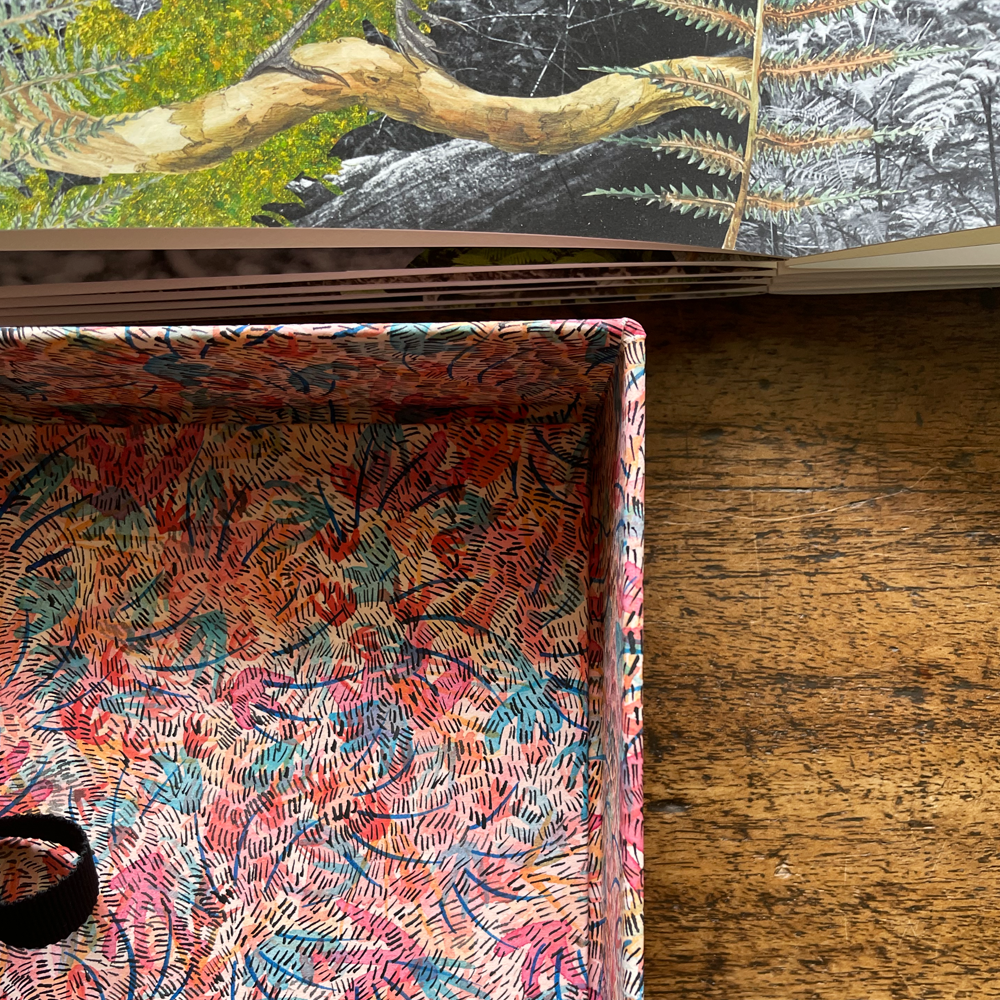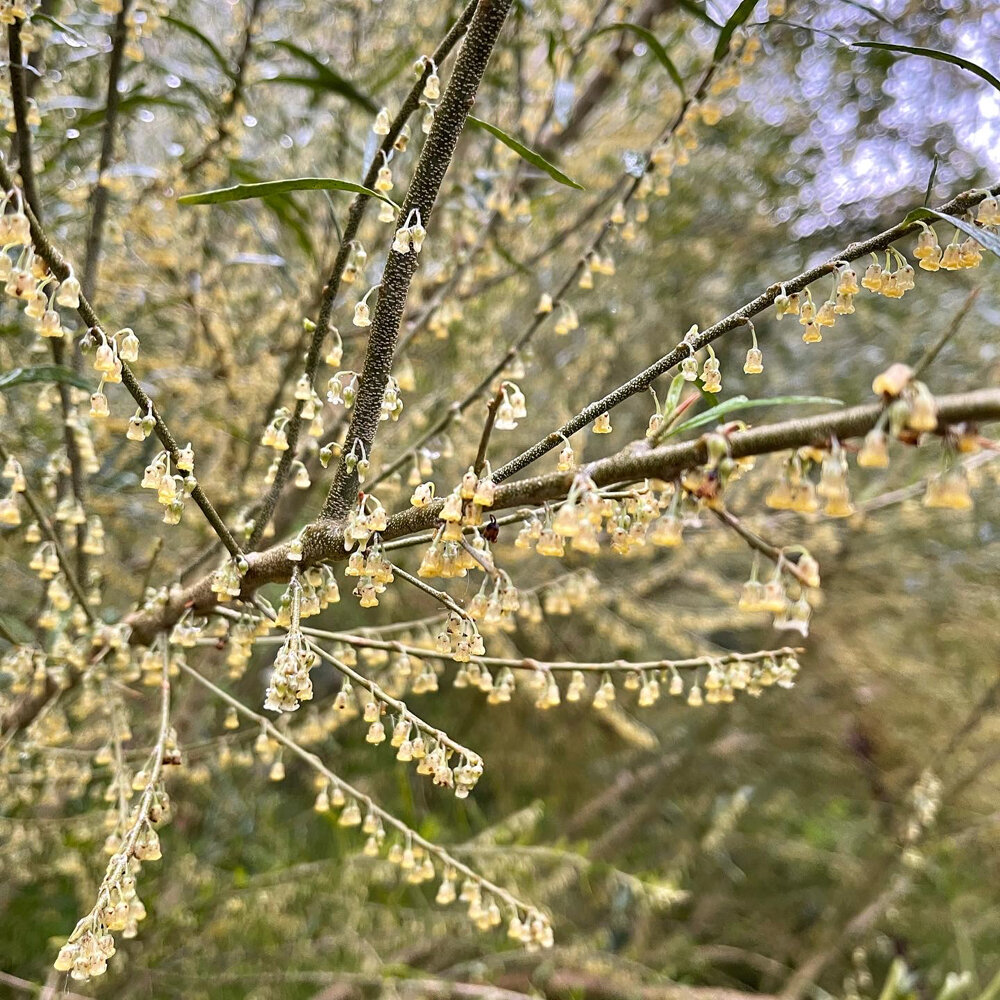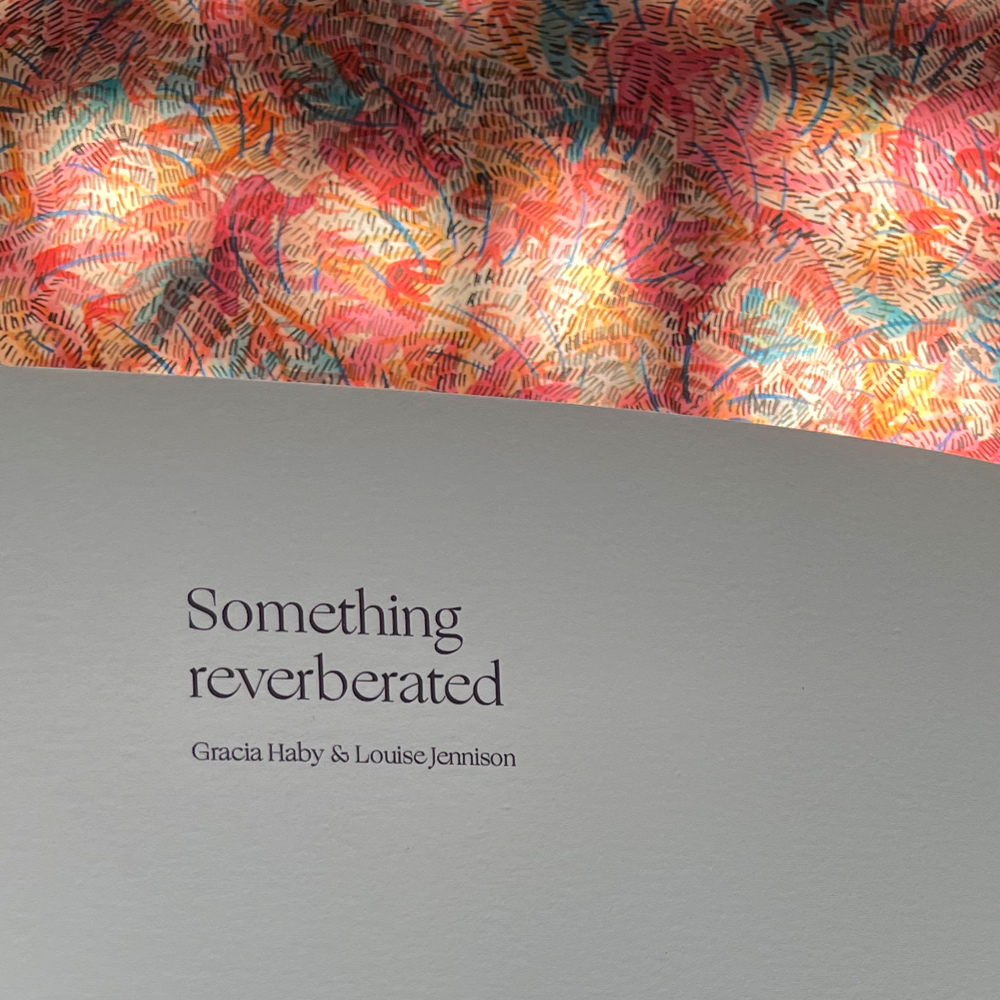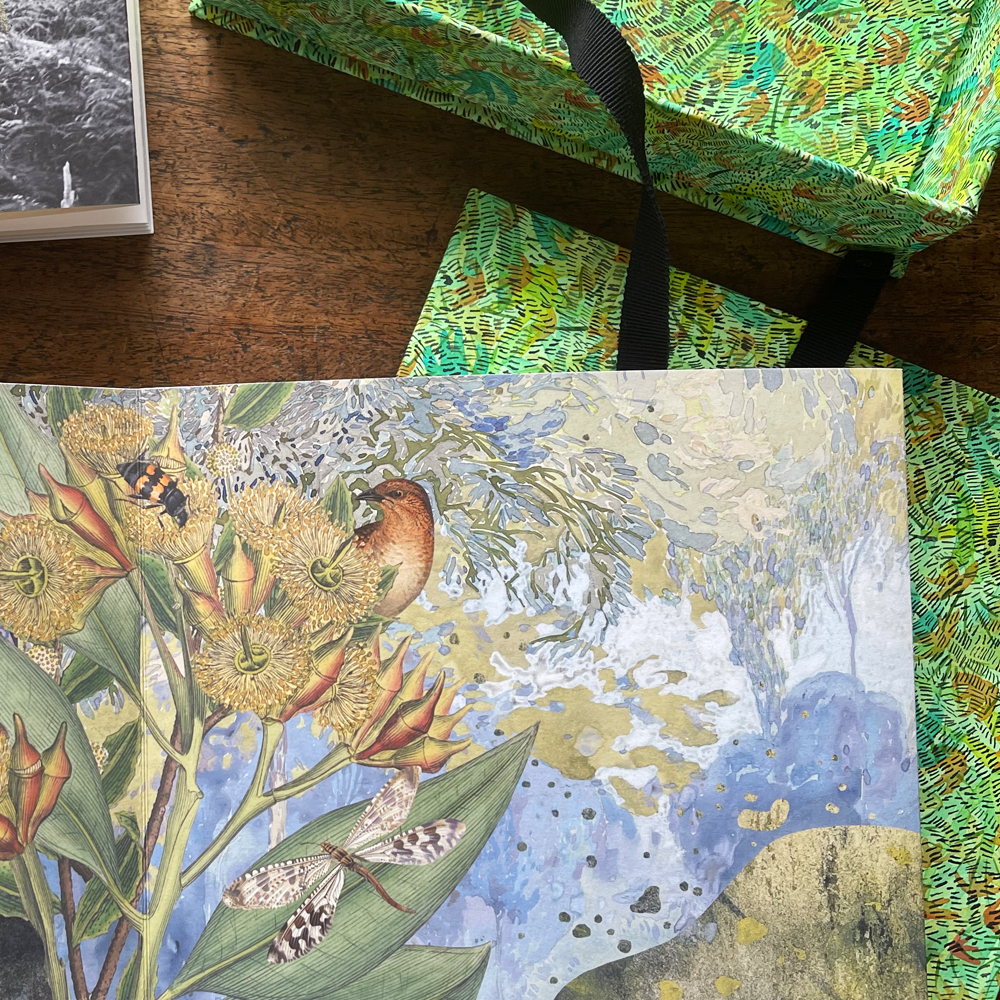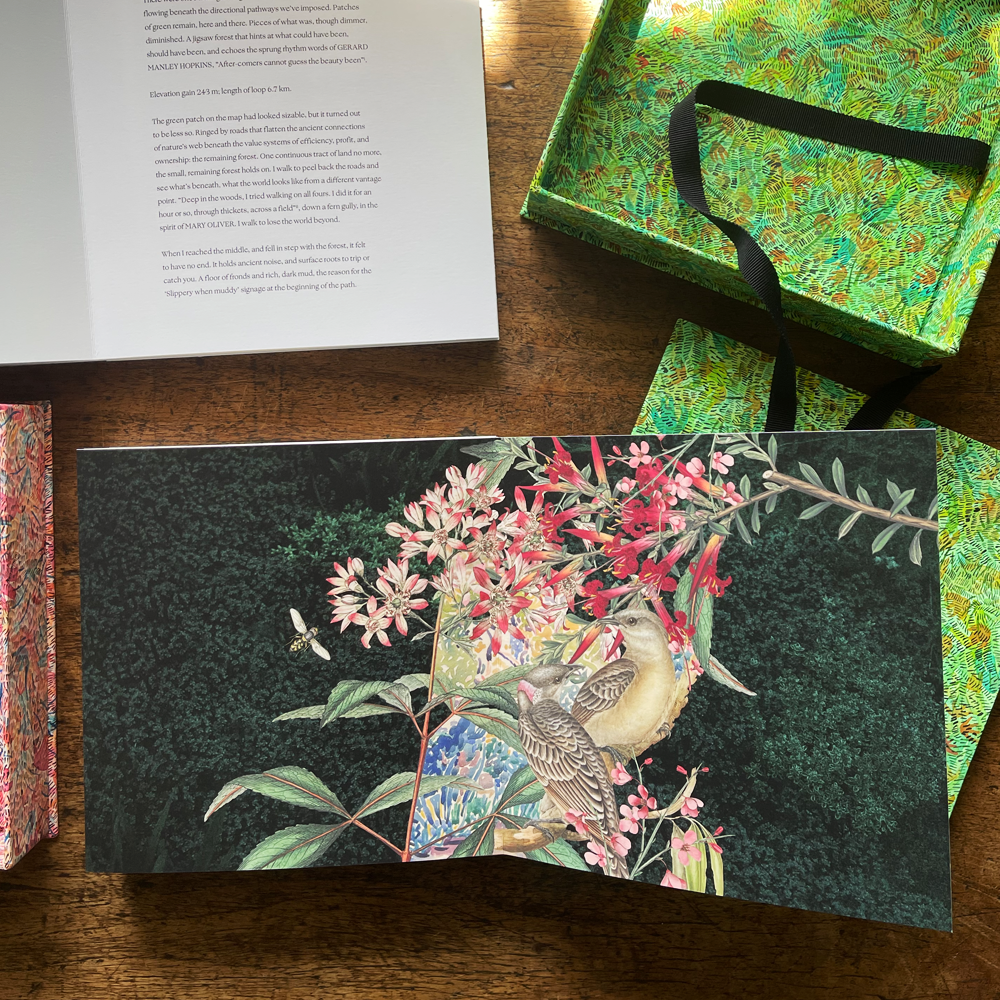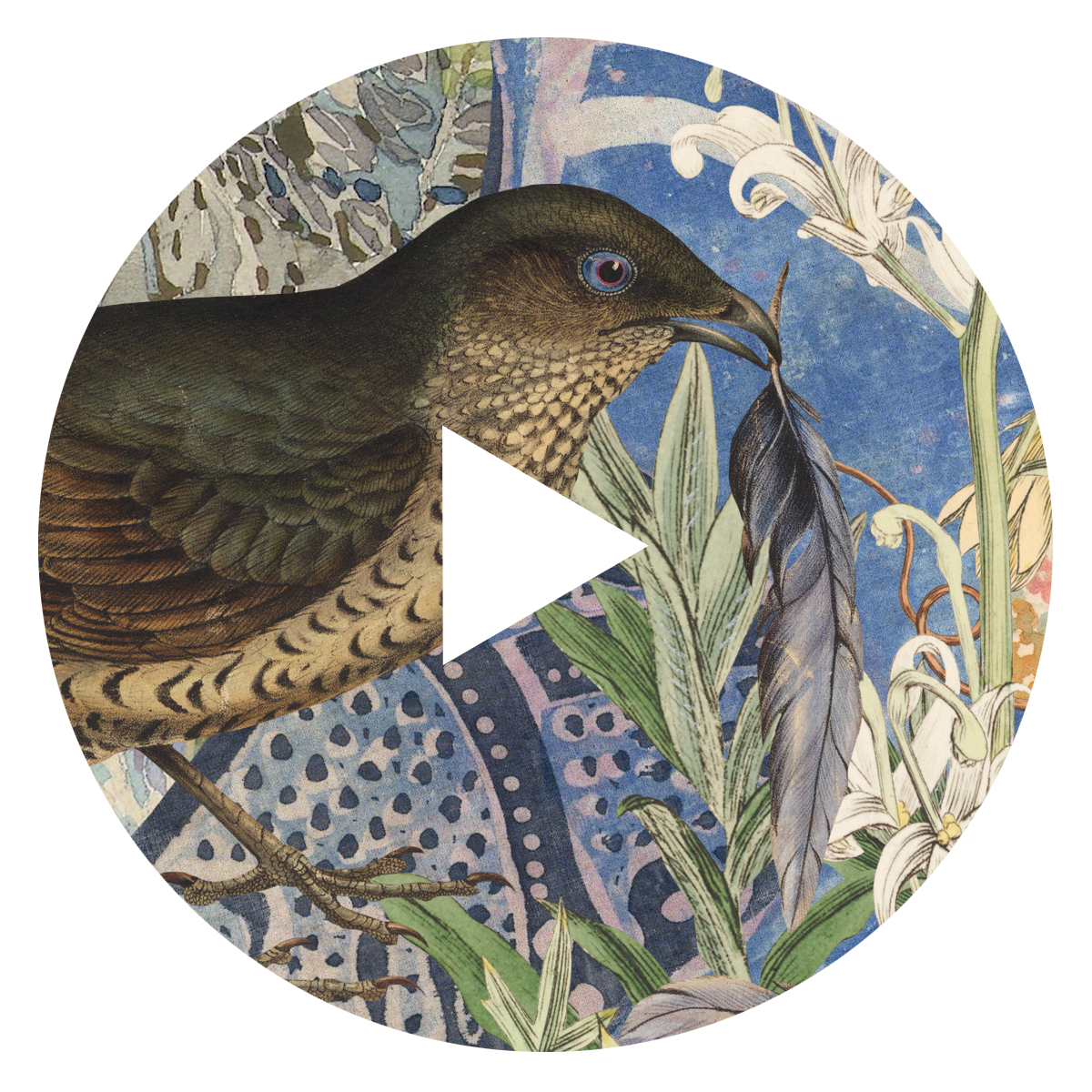WITH WINGS OUTSTRETCHED AND QUIVERING
Empty the room. View it from the outside in. Brick by brick. Twig by twig. At the beginning: what is there?
With wings outstretched and quivering: Gracia Haby, 2021
World of the Book, State Library Victoria, 2024–2025
Paper Universe: The Book as Art, State Library of NSW, 2025–2026
Gracia Haby & Louise Jennison
With wings outstretched and quivering
2021
18 page concertina artists’ book, inkjet print on Canson Arches 88 310gsm, with accompanying narrative (by Gracia Haby), housed in a box (by Louise Jennison) with original watercolour cover on Saunders Waterford Aquarelle 300gsm white hot-press paper
Printed by Arten
Edition of 2
The original Bowerbird collages, of which this artists’ book is a variation of, were created especially for Genevieve Lacey’s Bower. Bower was released as an album by ABC Classic on the 14th of May, 2021.
The collages feature bowerbirds from Elizabeth Gould’s hand coloured key plates from The Birds of Australia (1840–1848), in the collection of the State Library of NSW, and illustrated botanical works by Ferdinandi Bauer from Illustrationes florae Novae Hollandiae (1813), and James Sowerby’s engravings within the Specimen of the botany of New Holland (1793), both in the collection of State Library Victoria.
Great bowerbird (Chlamydera nuchalis)
Satin bowerbird (Ptilonorhynchus violaceus)
Spotted bowerbird (Chlamydera maculata)
With wings outstretched and quivering was one of 34 shortlisted works in the 2021 Geelong acquisitive print awards at Geelong Gallery.
The two editions of this artists’ book have been acquired by State Library Victoria and the State Library of NSW.
In 2024–2025, With wings outstretched and quivering was on display as part of the Contemporary Victorian Artists display, Inspired by the Collection, as part of World of the Book, at State Library Victoria. In 2025–2026, With wings outstretched and quivering is currently on display as part of Paper Universe: The book as art, at the State Library of NSW.
●
2021 Geelong acquisitive print awards
SATURDAY 18TH OF SEPTEMBER – SUNDAY 17TH OF OCTOBER, 2021
GEELONG GALLERY, LITTLE MALOP STREET, GEELONG
This nationally acclaimed acquisitive prize exhibition features entries from around Australia by established and emerging printmakers representing the diversity of current practice through both traditional printmaking techniques as well as contemporary processes.
The artists shortlisted for the 2021 Geelong acquisitive print awards are Carlos Almenar Diaz, Rosalind Atkins, Kim Barter, Steph Bolt, G W Bot, Gavin Brown, Jon Campbell, Susanna Castleden, Matthew Clarke, Marian Crawford, Jo Darvall, Jan Davis and Jan Palethorpe, Lesley Duxbury, Kasia Fabijańska, Robert Fielding, Dianne Fogwell, Steven Giese, Sharon Goodwin and Irene Hanenbergh (Zilverster), Kate Gorringe-Smith, Gracia Haby and Louise Jennison, Christine Johnson, Locust Jones, Martin King, Pia Larsen, Chips Mackinolty, Tim Maguire, Aylsa McHugh, Christopher Orr, Janet Parker-Smith, Ben Rak, Geoffrey Ricardo, John Ryrie, Cleo Wilkinson and Helen Wright.
Geelong Gallery
﹏
RELATED LINKS,
BOWER
GENEVIEVE LACEY
ABC CLASSIC
SOMETHING REVERBERATED
360° VIRTUAL TOUR (GEELONG GALLERY)
RELATED POSTS,
A PAPER UNIVERSE EXPANDS IN THE LIBRARY
PAGE PREENING AND COSTUME TURNING
”SAYING THINGS, IN WORDS BEFORE WORDS”
BIRDS, WE’RE CURIOUS FANS
LOCATING A TEXTILE WREN (AMYTIS TEXTILIS) WITHIN VOLUMES
COLLECTION BOUND
READY
FOR THE READING
COLLAPSE IN FOLDS LIKE THOSE OF A CONCERTINA
WITH WINGS OUTSTRETCHED AND QUIVERING
A HIGHLY THEATRICAL DISPLAY
LYREBIRDS AND BOWERBIRDS
ANOTHER COAT ON THE SHEETS OF PAPER WHICH WE WILL USE AS FABRIC
TRYING TO KEEP PACE WITH THE CALLS OF THE GALAHS AND THE BOWERBIRDS
HIDDEN IN THE UNDERGROWTH
With wings outstretched and quivering
Empty the room. View it from the outside in. Brick by brick. Twig by twig. At the beginning: what is there?
If I were to construct a bower: where would I begin? What piece would I put where? What piece would I first arrange? Brick by brick, a dwelling. Twig by twig, a bower. It has existed long before me. It was made for shelter, in a pattern of houses that all look like each other. One house followed the other. Row by row. Suburb by suburb. A uniform carpet of homes, when viewed overhead, but with little gentleness for what it covered in the process. Muffled beneath the concrete slabs: do the thin threads of mycelium hold? I click the ‘Satellite’ thumbnail at the bottom of the map for a bird’s eye view. I lose myself in how small I am in all of this, and how little I feel I guide.
Zoom in.
Find a dent and burrow in.
In my bower, as it currently stands, rooms branch from a passageway, affording security, shelter, and sustenance. All that is needed. An above-ground echo of the snug, self-sustainment of Kafka’s below-ground burrow: “I have made the burrow habitable, and I think it has shaped up well.”[i]
My above-ground burrow fits the first definition of the word ‘bower’ in the Oxford English Dictionary.
1.
a. A dwelling, habitation, abode. In early use literal. A cottage; in later use a poetical word for ‘abode’.
Its etymology, bower, n.1
Old English búr dwelling, etc.
Frequency (in current use):
In typical modern English usage, the word ‘bower’ is a faint sound on the frequency band. Shelved alongside rewrite, nutshell, candlestick, insectivore (nouns), astrological, insolent, methylated (adjectives), sequester, cull, plop, honk, befuddle (verbs), methodically, lazily, pleasantly, al dente (adverbs). By this definition and my understanding, my bower, is cosy and full, rewritten, often, with candlesticks, somewhere, but not the elaborate kind. I join its meaning with protection, and make of it a new nest, lined with trinkets of personal meaning and regular use.
I look about me to see what blue objects a Satin bowerbird (Ptilonorhynchus violaceus) might borrow from me for their own display. All the Field Guides I’ve consulted suggest thievery, with the fallen ultraviolet-reflecting tail feathers of the Crimson rosella (Platycercus elegans) rating as the most precious item and, as such, they are frequently plucked from bower to bower. But I do not have any such feathers, nor blue milk lids in the kitchen neither; they are soy, white and forgettable to me. I do have blue pencils. Both graphites in their blue Staedtler sleeves and blue-all-the-way-through coloured pencils. Blueberries in a tiny bowl. A blue ceramic coffee press. The blue spines of books on the shelves. A blue jumper like the night sky. A blue jumper like the sky before it in the afternoon. One like a rainy day too. I don’t have many things for their bower, after all. They’re too big and useless to the bowerbird.
All the same, they are welcome to them.
It seems I have joined the first definition of ‘bower’ as a dwelling, with the fourth, in my befuddlement.
4. A structure reared by the bower-bird.
1869 H. A. Nicholson Manual of Zoology. (1880) lxvi. 625 These curious birds have the habit of building very elaborate bowers.
These bowers are wholly independent of their nests.
I’ve been focusing on the wrong part. What if my lesson was more akin to what a bowerbird does when they create a bower. A bower to the bowerbird is not a dwelling. A bower is an avenue created which affords an optical illusion. It is fashioned, slowly, with the intention of changing the point of view of the spectator, in the cup of the bower, by directing their gaze. It is like a seat in the theatre from where you watch the performance unfold. A viewing cradle made of many upright reddish twigs, it shields a part of your vision, enabling you to focus on the stage and the considered placement of forms.
A bower is a gentle curve around you. The reddish hue, no accident, rather a means to induce chromatic adaptation[ii].
In such a hold, the Great bowerbird (Chlamydera nuchalis) can create a sense of things being smaller or larger than they actually are, by placing small objects close to the avenue entrance and larger objects farther away. A lolly wrapper, a clothes peg, a shine of worn glass, tossed to and fro. A peek around the corner. A dance. A loud ‘weeoo’ call[iii].
The bowerbird nudges a discarded plastic fork stage right. They view it from the avenue, in rehearsal. They nudge it across a little more. The better the gradient, the better the pattern. The better the pattern, the better the illusion.
I borrow from them, a shift in emphasis from collector of safe harbour trinkets to a way of focusing on the positive, maintaining hope through perspective.
Give a loud descending whistle!
This is where I’ll begin.
Notes:
[i] Franz Kafka, ‘The Burrow’, The Complete Stories, ed. Nahum N. Glatzer (Shocken Books: New York, 1983), p. 325.
[ii] Laura A. Kelley and John A. Endler, (2017), ‘How do great bowerbirds construct perspective illusions?’, Royal Society Open Science, Volume 4, Issue 1, January 2017, pp. 1–10, accessed 1st July, 2021.
[ii] Jennifer Ackerman, ‘Bower’, in accompanying booklet, Genevieve Lacey and Marshall McGuire, Bower, recorded 15th–19th December, 2020, ABC Classic, 2021, compact disc.
Inspired by the Collection
World of the Book
TUESDAY 25TH OF MAY, 2024 – SUNDAY 18TH OF MAY, 2025
DOME GALLERIES, LEVEL 4, THE DOME, STATE LIBRARY VICTORIA, 328 SWANSTON STREET, MELBOURNE
All artists are in dialogue with art’s history, and its present. The library’s rich book collection has long been a source of inspiration for artists working in many media.
This display highlights the special resonance of our natural history collection for select Victorian artists whose work is concerned with the form of the book. The resulting artworks and artists’ books have in turn been added to the state collection.
Shown alongside the historical works that have inspired them, these contemporary artworks also celebrate the power of art as activism at a time when the fragility of our natural world has never been more evident.
The artists and natural history section of World of the Book features:
John Cotton's original sketchbooks of birds from the Port Phillip District (known as Victoria after its separation from the Colony of New South Wales in 1851).
A monumental work by Martin King, Tree of Life, Diary of Lost Souls in Twenty Volumes, created for the City of Melbourne's CLIMARTE exhibition that draws directly from John Cotton's sketchbooks and the beautiful Fitzroy Gardens.
A response to the natural history collection by contemporary Victorian artists' book creators Gracia Haby and Louise Jennison, with their inspirational fusion of words, collages, drawings and prints.
Gracia and Louise have been creating art together since 1999. The fusion of their words, collages, drawings and prints has forged a unique aesthetic. Their work as wildlife foster carers and environmental activists guides their art practice as well as their daily lives. It imbues their artists’ books with authenticity and integrity.
— Inspired by the Collection, Contemporary Victorian Artists, Dr Anna Welch, Principal Collection Curator, History of the Book, Collection Development & Description, State Library Victoria
Paper Universe: The book as art
MONDAY 11TH OF AUGUST, 2025 – SUNDAY 3RD OF MAY, 2026
GALLERIES, STATE LIBRARY OF NEW SOUTH WALES, 1 SHAKESPEARE PLACE, SYDNEY, NSW
Beneath the Library’s surface, hidden deep underground across nine different locations in the stacks, lies an extraordinary, glittering and unlikely collection of art — over 700 items strong — that transcends the expected. Mysterious, elusive and often perplexing, artists’ books challenge our definitions of what a book is, and our traditional methods of displaying books. This wondrous paradox is soon to take centrestage in a major exhibition called Paper Universe: The book as art. It offers a rare chance to experience some of the collection’s most unique and captivating examples of artists’ books, revealed in all their complexity.
…
Artists’ books are as complex and diverse as artistic expression itself, and often push the boundaries of traditional definitions. Simply creating or writing a book doesn’t make it an artist’s book; for example, an artist’s sketchbook, or a book with illustrations, does not qualify. What sets an artist’s book apart is the artist’s intention to create the book as a work of art.
All the elements they contain — materials, text, layout, design and format — represent a deliberate choice by the artist and their collaborators. Each component invites the reader to explore how it contributes to the work’s meaning and how it transforms the book into an art object.
Audiences are increasingly open to viewing films, art and music as ‘texts’ on par with traditional literature. In this vein, artists’ books happily blur the line between text and art, turning the book into a work where visuals contribute equally to meaning and experience.
…
Almost any subject matter, or the style of its execution, can become the ‘canvas’ for an artist’s book. This boundless medium unfolds most vividly in the diverse formats where artists blend timeless techniques with bold experimentation.
Artists’ books invite us to rethink how we perceive and engage with art. They urge us to reconsider the world around us and the very concept of a ‘book’ — its essence, content and structure. They push the limits of design, illustration and storytelling, forever expanding what a book can be.
Maria Savvidis, Paper Universe, Openbook, Winter 2025, State Library of NSW, pp 12–19


